Our Stories
Improving the lives of people and animals is part of our mission at LSU Vet Med, and we are proud to share some of our mission stories with you.
2022
Soldier Home from Iraq Is Reunited with Dog Treated for Brain Tumor


Published September 27, 2022
Brandon and Sophie, the family’s miniature schnauzer, grew up together as best friends. Sophie slept on Brandon’s bed, kept him company in the garage when he rebuilt his car in high school, and followed him wherever she could, according to Brandon’s dad, David. But she couldn’t follow Brandon when he was deployed overseas with the U.S. Army for nine months.
During the time Brandon was stationed on the other side of the world, Sophie was diagnosed with a brain tumor.
“I didn’t know if my son and Sophie would see each other again,” David said.
Brandon flew home to see Sophie at Christmas 2020. Before returning to Louisiana, he had to quarantine in Alaska. Meanwhile, Sophie was undergoing treatment at the LSU School of Veterinary Medicine’s oncology service.
“We treated Sophie with radiation. Our first goal was to get her to see Brandon again when he came home for Christmas,” said Jennifer Merkle, DVM, radiation oncology resident.
When Brandon finally arrived at the New Orleans airport, Sophie was there to enthusiastically greet her best friend after a lengthy absence.
“Watching Sophie see him again was the best Christmas gift for us,” said David, who sent Dr. Merkle a video of the reunion.
“I love the joy she shows when she sees him after so long. It’s always wonderful to see happy moments when the quality of their life is good. It’s the most rewarding of what we do in oncology,” said Dr. Merkle.
The first indication something was off with Sophie came in May 2020, when she had a seizure. Seizures are caused by inflammation associated with a tumor and happen when the brain gets overwhelmed and sends out too many signals at once.
David Moores, DVM (LSU 2003), Sophie’s primary care veterinarian at Tchefuncte Animal Hospital in Madisonville, La., diagnosed her with the tumor. She was also seen by veterinary neurologist Roy “Boogie” Yates, Jr., DVM, of Baton Rouge Veterinary Specialists. Sophie was referred to the Oncology service at LSU Vet Med for radiation therapy.
“When we radiate dogs with brain tumors, we expect the seizures to continue but with less frequency. Along with radiation, anti-inflammatory steroids and anti-convulsant drugs are prescribed. Dogs like Sophie remain on the medications for the rest of their lives,” Dr. Merkle said.
With treatments, survival time is expected to be about one year or more. Sophie’s seizures became less frequent, an indication the treatments were helping.
“It takes a few months to see a difference,” Dr. Merkle said.
Sophie was a favorite when at LSU Vet Med. “She stayed near us when at the hospital. She worked her way around to all of our desks. The same students took care of her on each visit because they have a bond with their patients,” Dr. Merkle said.
When Brandon’s parents brought Sophie to LSU Vet Med in January for a checkup, Brandon had already returned to Alaska.
As of May of 2021, Sophie has been seizure-free since January. Her monthly treatments were reduced to once every three months because she has been doing so well.
“We’re thankful for everyone at the LSU vet school,” David said
Writer
Sandra Sarr, MFA
Communications Manager
Caring for the General’s Horse
Lt. Gen. Russell Honoré with Red
Lt. Gen. Honoré, who delivered relief to Katrina-ravaged Louisiana, trusts LSU Vet Med to deliver comprehensive care for Big Red
Published on January 20, 2022
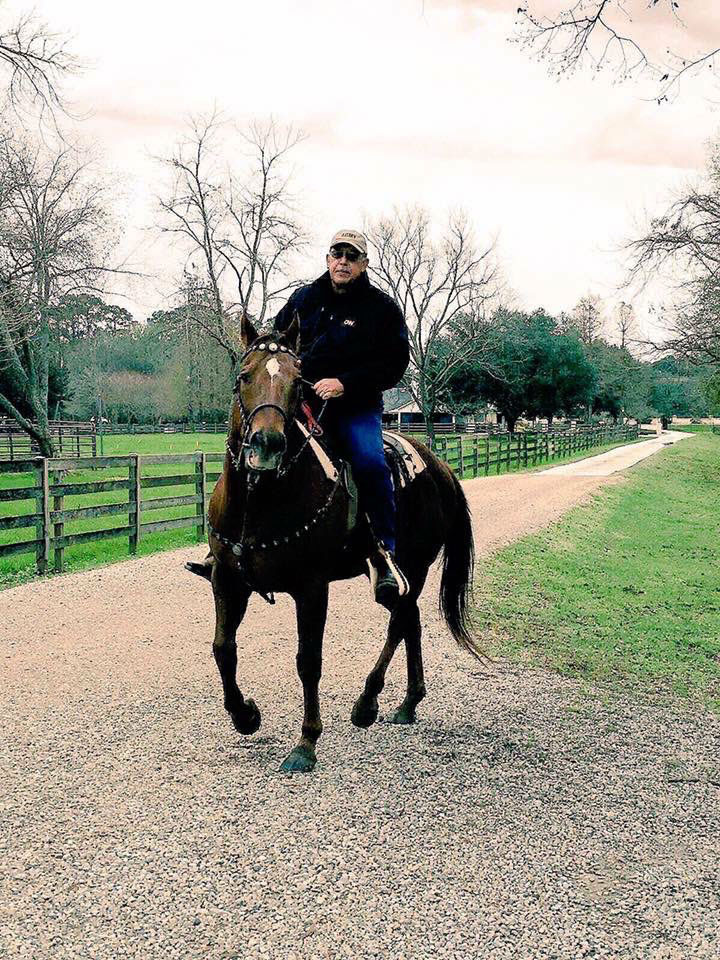
When Lt. Gen. Russel Honoré’s beloved horse, Big Red, needs medical attention, he brings him to the LSU School of Veterinary Medicine, where Big Red receives care from a multi- disciplinary team of clinical experts.
The general’s horse attracts legions of fans on social media who follow updates on his health posted by Lt. Gen. Honoré, who has his own army of devoted admirers for his post-Hurricane Katrina life-saving relief efforts. Fans regularly inquire about Big Red’s health and post well wishes for him.
In September 2021, Big Red was limping and having trouble urinating. He was brought to LSU Vet Med’s Large Animal Hospital and was seen by clinicians specializing in equine medicine, surgery, and podiatry with a therapeutic farrier who specializes in custom horseshoes. Big Red was diagnosed with the beginnings of kidney disease. When he returned for his one-month checkup, veterinarians discovered a hoof abscess possibly caused by blunt trauma.
His care was coordinated between various hospital services, ensuring that medication prescribed for his feet would not put extra strain on his kidneys.
“Because he’s older, his kidneys don’t function as well as before. There are no specific medications for this condition. His most serious issue is his front foot. He has ongoing chronic issues with both front feet due to thin soles. Keep in mind that horses bear 60 percent of their weight on their front legs,” said Rose Baker, BVMS, assistant professor of equine internal medicine and lead veterinarian during his latest visit to the Large Animal Hospital.
Dr. Baker worked in collaboration with Jonuel Cruz, DVM (LSU 2015), of the equine surgery service to provide comprehensive care of both his medical and orthopedic needs.
During Big Red’s recent hospital stay, clinicians kept his hoof area clean to prevent infection. And he was fitted with a custom shoe designed and built by Clay Curry, therapeutic farrier for LSU. Forged of steel with a wedge pad to correct bony alignment in his hoof, a cushioned shock absorber was added to relieve pressure and add comfort. The shoes were fabricated at the LSU Large Animal Hospital in Curry’s mobile farrier unit.
Comprehensive Care
“We build a strong working relationship between the farrier and veterinarians. As surgeons, we express an idea to the farrier and then listen to what he has to say. He brings extensive experience from a slightly different angle to help solve the same problem,” Dr. Cruz said.
“Big Red’s care is a mixture of science, experience, and judgment. Each person on the team has a respected body of knowledge that contributes to his healing. All are experts working together to do what is best for the animal,” Lt. Gen. Honoré said.
While Big Red was hospitalized, the general called every morning to receive updates on his horse’s condition. Alasdair Botting, DVM, equine internal medicine house officer, was his primary point of contact with the clinical team. With Big Red’s newly fitted shoe and abscess healed, he was released after seven days hospitalized. When the horse was led back into his home pasture, he felt well enough to take off running and roll around in the grass.
Each day, Big Red waits at the fence for Lt. Gen. Honoré, who visits him in the morning and afternoon and feeds him his evening meal. The horse, now fully mobile, comfortable, thriving, receives checkups at LSU Vet Med every four to six weeks.
“He gets comprehensive care at the vet school. It’s by luck that we are nearby, and my horse can be healed at one of the finest vet schools in the country. I couldn’t have planned it any better,” said the Baton Rouge resident who received Big Red as a retirement gift in 2011 and has been bringing him to LSU Vet Med ever since.
Honoring Honoré
What is it like to care for the horse of a man who has been called an American hero, a high-profile general with exacting standards?
“Knowing you’re helping someone who has done so much for Louisiana is very fulfilling. I told my team member, who is not from the U.S., ‘This guy is kind of important,” Dr. Baker said.
“Lt. Gen. Honoré likes having a plan. He’s very to-the-point. He also listens well and is very receptive to our treatment plans. When we explain the best ways to address Big Red’s problems moving forward, the general tells us, ‘Whatever he needs—I want what’s best for him,’” Dr. Botting said.
Equine veterinarians who have cared for Big Red over more than a decade include Drs. Laura Riggs, Frank Andrews, Mustajab Mirza, Anne Chapman, Heidi Banse, and Britta Leise. Cherie Pucheu, DVM (LSU 1992), PhD, DACVD, associate professor of veterinary dermatology, also has seen Big Red. They say he is a sweet, affable horse who cooperates with care providers even when he is not feeling his best.
“We’ve all had a chance to put our hands on him,” Dr. Baker said.
Mustajab Mirza, DVM, DACVS, associate professor, came in on a Sunday (his day off) to treat Big Red when he had colic. Lt. Gen. Honoré remains grateful and slightly in awe of his dedication.
“At the LSU vet school, they know Big Red is family to me,” he said.
The Human-Animal Bond
It was love at first sight for the general and Big Red, who was given to the general
11 years ago from Harvey Honoré as a retirement gift.
“When I first rode him, he was calm, pulled to a full stop and stayed still. He’s one of the most well-broken horses I’ve ever encountered. He’s not easily spooked,” said Lt. Gen. Honoré.
Big Red’s original name was Crimson Pie, after his father, Pie-in-the-Sky, a winning racehorse descended from the famous Man-o-War. His inner lip was tattooed with a number for racing. However, racing wasn’t his forte, and the registered Quarter Horse spent eight years as a cow horse on Louisiana politician Foster Campbell’s ranch before the general claimed him as his own.
Growing up the eighth of 12 children in rural Lakeland, La., in Point Coupee Parish, Russel Honoré rode horses on the farm his family rented. He worked on a dairy farm from age 12 until he graduated from high school. Rising at 4 a.m., he mounted a horse, and led cows to the barn for milking. The dairy farmer’s son was a veterinarian, and young Russel aspired to enroll at LSU Vet Med and become a veterinarian.
He belonged to 4-H and showed Guernsey cows in New Roads, La. While a student at Southern University, he milked cows on the weekend and bought his first horse, Big Dan.
His lifelong association with animals is deeply rooted in his Creole heritage.
“I loved to listen to the old Creole men sit on the porch and tell stories of their youth while sharing a half pint of Bourbon de Luxe. They talked about their mules and took pride in them because they were central to their livelihood. The mules plowed the gardens, cut the hay, brought in the corn and sugar cane. They laughed about how cantankerous the Creole mules of South Louisiana were.
“I admired the old men because they were telling the story of America. These were stories of survival, of raising families and crops and depending on animals. They ate well and shared their resources. Their stories were of the human experience. It was a simpler time,” he said.
He recalled seeing how the Creole men he admired were treated when they went into town, and it still saddens him as he describes those memories while seated outside the LSU Large Animal Hospital on a sunny afternoon wearing a cap emblazoned with the word ARMY.
He had enrolled in the Army ROTC, a four-year commitment, while a student at Southern. After graduating with a B.S. in vocational agriculture he answered the call to serve our country in the U.S. Army. During his 37-year military career, he rose through the ranks and retired from the U.S. Army as a three-star general in 2008.
Now, Lt. Gen. Honoré commands what he calls the Green Army fighting toxic pollution in Louisiana’s Cancer Alley. He has authored several books and travels the world as an in-demand public speaker, consultant, and media commentator on leadership, climate change, disaster preparedness, and national security.
No matter where the general is in the world, he never misses a day of calling to check on Big Red.
About LSU Vet Med: Bettering lives through education, public service, and discovery
The LSU School of Veterinary Medicine is one of only 32 veterinary schools in the U.S. and the only one in Louisiana. The LSU SVM is dedicated to improving and protecting the lives of animals and people through superior education, transformational research, and compassionate care. We teach. We heal. We discover. We protect.
Writer
Sandra Sarr, MFA
Paralyzed dog walks again after just days of therapy at LSU Vet Med
Published January 14, 2022
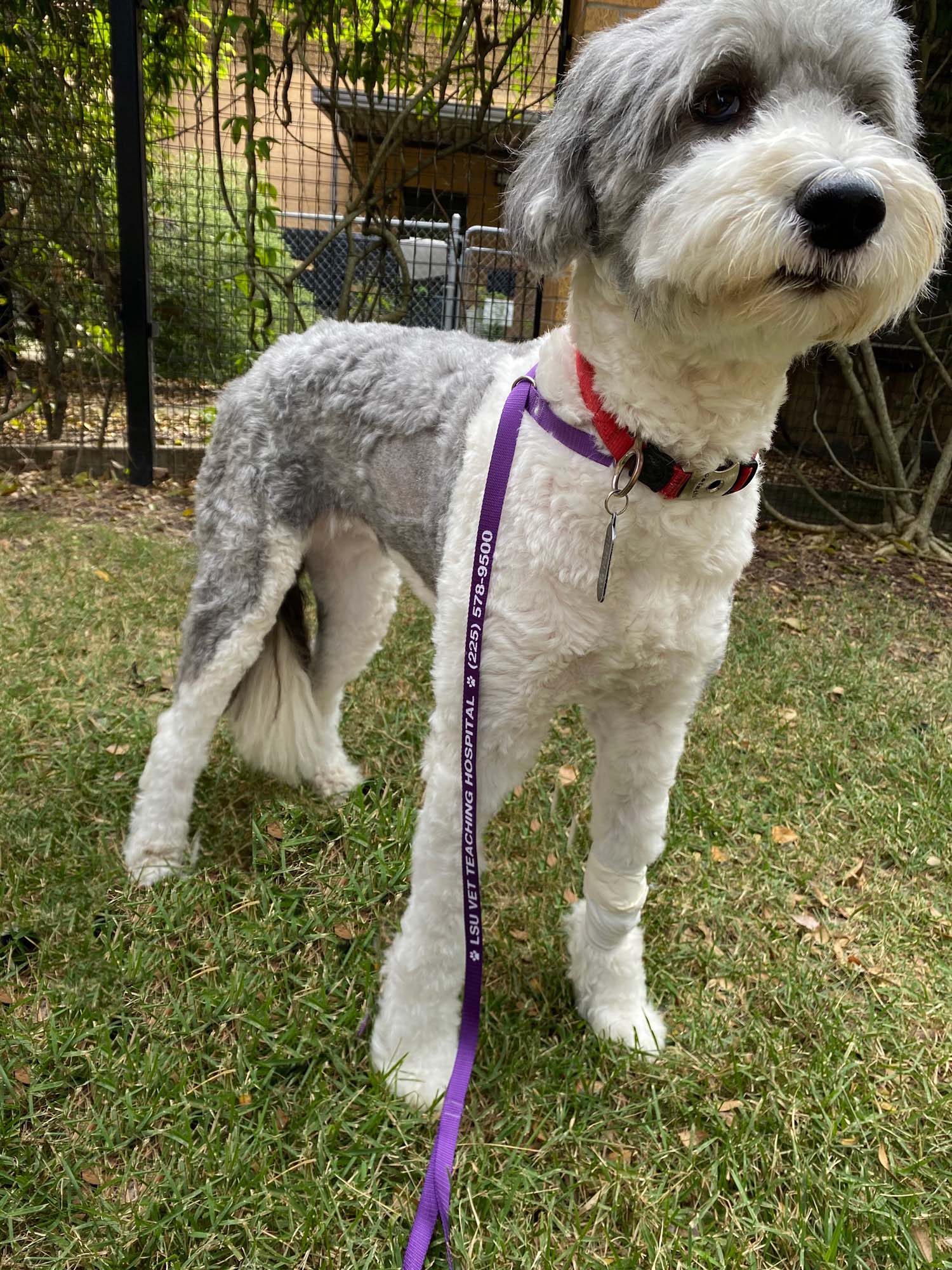
Keitha and Keith Marcotte of Shreveport, La., were vacationing in Florida when the couple received a phone call from their dog sitter with awful news. Shelby, their five-year-old English sheep dog-poodle mix, had collapsed while chasing a ball down a hill. Severely injured, she was unable to stand up. Because he could get to Shelby first, their son drove from Dallas to Shreveport to pick her up and bring her to the LSU School of Veterinary Medicine.
Hind limbs paralyzed, Shelby was diagnosed with a spinal cord injury, fibrocartilaginous embolism, or FCE, which happens when a piece of cartilage from a disk blocks blood flow to the spinal cord. The Marcottes were afraid she would never walk again. As long as the spinal cord hadn’t died, blood flow and nerve function could return. An FCE diagnosis would offer a better chance of recovery than other types of spinal disc injuries.
When Shelby arrived at LSU Vet Med on Oct. 18, 2021, she was wheeled into the Emergency and Critical Care Service, evaluated, and given an MRI. Dr. Daniel McCarthy, small animal surgery resident, further evaluated Shelby and determined, at best, she had a 50-50 chance of walking again.
“Sadly, there was no surgical remedy for Shelby,” Keitha said.
The couple decided to have Shelby seen by LSU Vet Med’s Integrative Medicine Service, where she underwent in-patient treatment for five days.
“The sooner we could get her in the hyperbaric oxygen chamber, the better chance for her recovery,” said Lorrie Hale, DVM, MS, CVTCM, assistant professor of integrative medicine and rehabilitation, who is certified in veterinary acupuncture, Tui-na, Chinese herbal medicine, and food therapy, which makes her one of the few certified traditional Chinese veterinary medicine practitioners in the world.
The hyperbaric chamber allows more oxygen to get into the tissue, helping the body to heal. Oxygen is needed to support cellular function.
Prior to her first hyperbaric oxygen treatment, Shelby was not able to stand. During the second day of treatment, she could stand but not walk. The following day’s treatment saw her standing but with minimal movement in her hips. Dr. Hale administered acupuncture and rehabilitation treatments, including the underwater treadmill. The next day, she had movement in her right hip, and the following day she was walking with support.
“Shelby is further along than I ever expected her to be,” Dr. Hale said.
Dr. Hale has successfully treated three dogs with injuries similar to Shelby’s. All three are walking again.
After only two weeks of treatment, she made a remarkable recovery and is now continuing acupuncture and rehab closer to home in Shreveport.
“We are so grateful for the expertise of the entire LSU Vet Med team—and especially Dr. Hale,” Keitha said.
Also serving on Shelby’s clinical team and providing excellent basic care were fourth-year students Allison Searcy, Kristel Echevarria, Kayla Fontenot, Paige Reagan (who were all taking part in their integrative medicine rotation), and Michael Polick (who was taking part in his surgery rotation).
LEARN MORE ABOUT OUR INTEGRATIVE MEDICINE SERVICE
Writer
Sandra Sarr, MFA
Communications Manager
2021
Yoshi, 15, Enjoys Good Quality of Life After Cancer Treatment; Contributes Medical Knowledge as Clinical Trial Volunteer
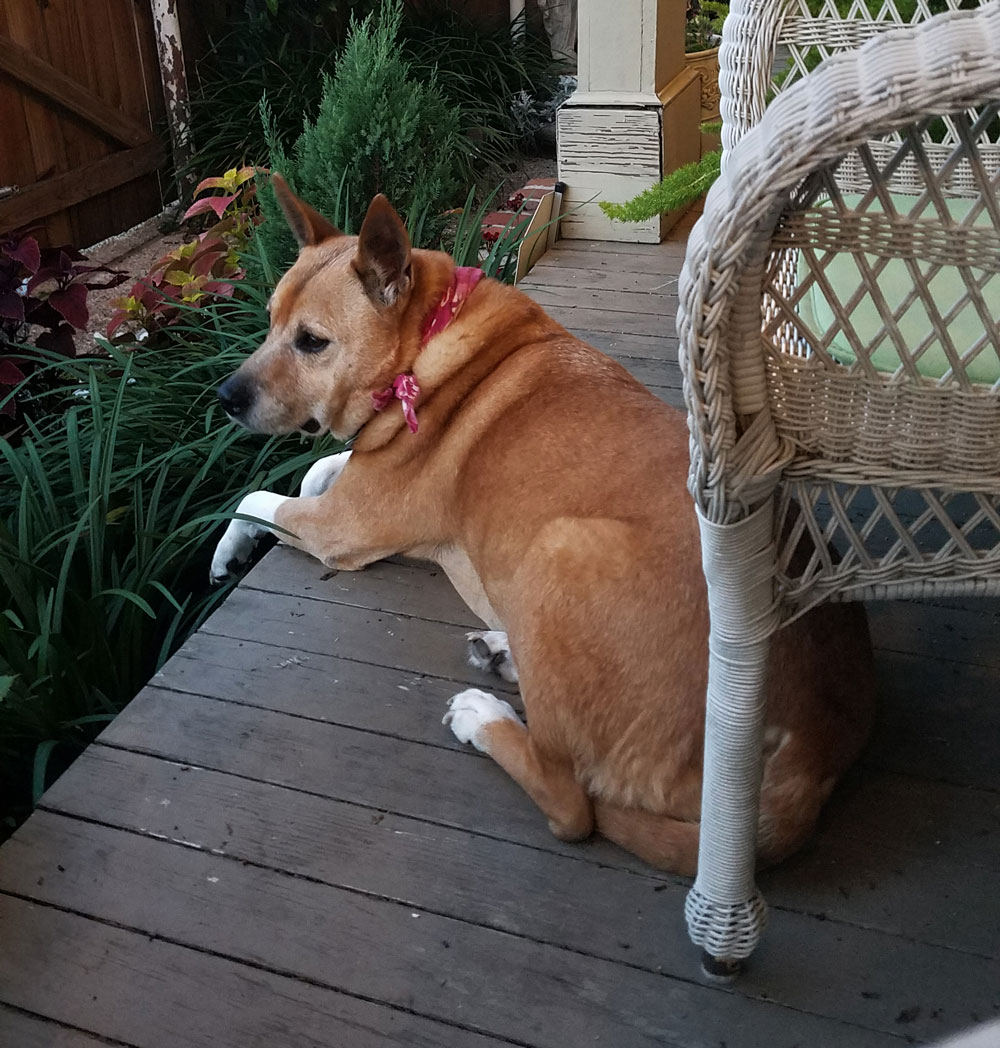 Published January 21, 2021
Published January 21, 2021
Sarah Senette gained an unexpected companion on a hiking trip she took immediately after Hurricane Katrina. A 10-month-old homeless dog joined her at the start and followed her all 26 miles. They bonded on the trail, and Sarah decided to claim her for her own. She named her Yoshi.
“When we met, I was listening to one of my favorite albums, Yoshimi versus the Pink Robots by The Flaming Lips. Her name got shortened quickly,” Sarah said.
Fifteen years later, at the start of COVID-19, Sarah noticed Yoshi having nose bleeds that didn’t go away. She took Yoshi to her longstanding veterinarian, Rachelle Biondolillo, DVM (LSU SVM 1997), at Prytania Veterinary Hospital in New Orleans. She was diagnosed with a cancerous nasal tumor. Sarah sought treatment for Yoshi at the LSU School of Veterinary Medicine, where she was seen in Oncology and Internal Medicine.
A CT scan and biopsy were done to help determine treatment options. The cancer had not spread to the lymph nodes. In addition to the nasal tumor, a pituitary tumor also was detected. It could not be biopsied. Sarah chose a course of four radiation treatments, one each week, during July 2020.
“At first, I was very nervous because, due to COVID-19, I would be unable to accompany Yoshi into the building and be as present as I would want to for the process. I really shouldn't have worried. Staff members were highly communicative and answered all of my many questions. The doctors provided me with lots of options for possible routes of treatment, including possible side effects and costs,” Sarah said.
Yoshi experienced no side effects from the radiation treatments, and she handled the brief periods under anesthesia well.
“It’s like we hit the reset button on her quality of life,” Sarah said.
“Our goal was to increase Yoshi’s quality of life. She was a pleasure to work with. She was a champ,” said Jennifer Merkle, DVM, radiation oncology resident.
Staff went out of their way to include sweet notes about Yoshi's personality on her medical records.
“What impressed me most is that every doctor I interacted with, from internal medicine to oncology, was compassionate and patient to the extreme. I was able to enroll Yoshi in a clinical trial for nasal tumors and the results were very good,” Sarah said.
“We are so grateful for Yoshi's contribution to our clinical trial. Each patient that enrolls in our trial helps us gain invaluable insight on how the immune system responds to radiation and expands our treatment options for future patients,” Dr. Merkle said.
Now, Yoshi is back to making roundtrip drives with Sarah from New Orleans to Lafayette, where Sarah teaches history at South Louisiana Community College. Upon completing radiation treatments, the entire Oncology Department signed an LSU bandana for Yoshi.
“Yoshi is leaving a legacy by participating in the clinical trial, contributing knowledge that may give other dogs with her same diagnosis more time with their loved ones. I will always be grateful for LSU’s expertise and consideration during this difficult time,” Sarah said.
Writer
Sandra Sarr, MFA
Communications Manager
Puppy Remy Helped Nicole Survive Cancer; Later Nicole Did Same for Remy
Published May 25, 2021
Remy was just eight weeks old when Nicole Rice Harris, a Registered Nurse in Alexandria, La., brought the boxer puppy home.
“Her official name is Hopeful Remission, Remy for short. I adopted her while I was going through cancer treatment. I knew that I would be home for about six months, and it would be the perfect time to adopt a pet,” Nicole said.
Nicole was diagnosed with cancer in July 2015. In August 2015, she underwent multiple surgeries. Remy was born that month. Nicole started chemotherapy in October and brought Remy home two weeks into her chemo treatment.
“She’s been a great companion. She gave me something else to focus on while my family was at work and school. Working with a new puppy really kept me active during cancer treatment,” she said.
After Nicole completed chemo, she underwent radiation for six weeks at M.D. Anderson Cancer Center in Houston. She finished all cancer treatments in late March 2016. By summer she felt better.
Four years later, in 2020, she noticed a lump on Remy that felt like a hard BB nodule on her neck. She knew from experience that it didn’t feel right.
“I don’t know if it was because I am in the medical field or if it was because I’d had cancer that I realized she had a suspicious lump and made an appointment,” she said.
She drove Remy to her veterinarian, Dr. Mark Gentry (LSU SVM 1994), of Fitzgerald Animal Clinic in Alexandria, where a biopsy and lumpectomy were conducted. Remy was diagnosed with a mast cell tumor. After surgery, they were sent home with pain medication and antibiotics and an incision extending from Remy’s jaw to her lower neck.
Nicole understood the seriousness of Remy’s cancer diagnosis. She decided to bring her to the LSU School of Veterinary Medicine, a four-hour roundtrip from Alexandria to Baton Rouge and back, for an expert opinion on next steps with Remy’s care.
“I wanted opinions from experts so that I could make a fully informed decision on how to move forward. Bringing her to LSU helped me make that decision,” she said.
“We found no evidence that the cancer her vet had removed had spread or returned yet.
She was given the options of additional surgery or radiation, or active surveillance as the likelihood of regrowth was not high,” said Jayme Looper, DVM (LSU SVM 1997), DACVR (RO), director of Small Animal Services and associate professor of veterinary radiation oncology.
“It was a pleasure to meet Remy and Nicole and discuss options for managing her mast cell tumor. I’m so glad Nicole found this information useful in her decision making,” said Sita Withers, BVSc, PhD, DACVIM, assistant professor of veterinary medical oncology.
“You go where you trust you’ll get the best of care. Remy will continue to be examined every three months by our local vet and follow up with LSU as needed,” Nicole said.
Remy is five years old now. She loves going on kayak paddles with Nicole on the lake near their Toledo Bend camp. This survivor even has her own life vest.
“She’s the best. Cancer created a deeper bond between us,” Nicole said.
Writer
Sandra Sarr, MFA
Communications Manager
Rare Flesh-Eating Disease Afflicts Dog; Innovative Treatment Saves Her Life
Published May 26, 2021
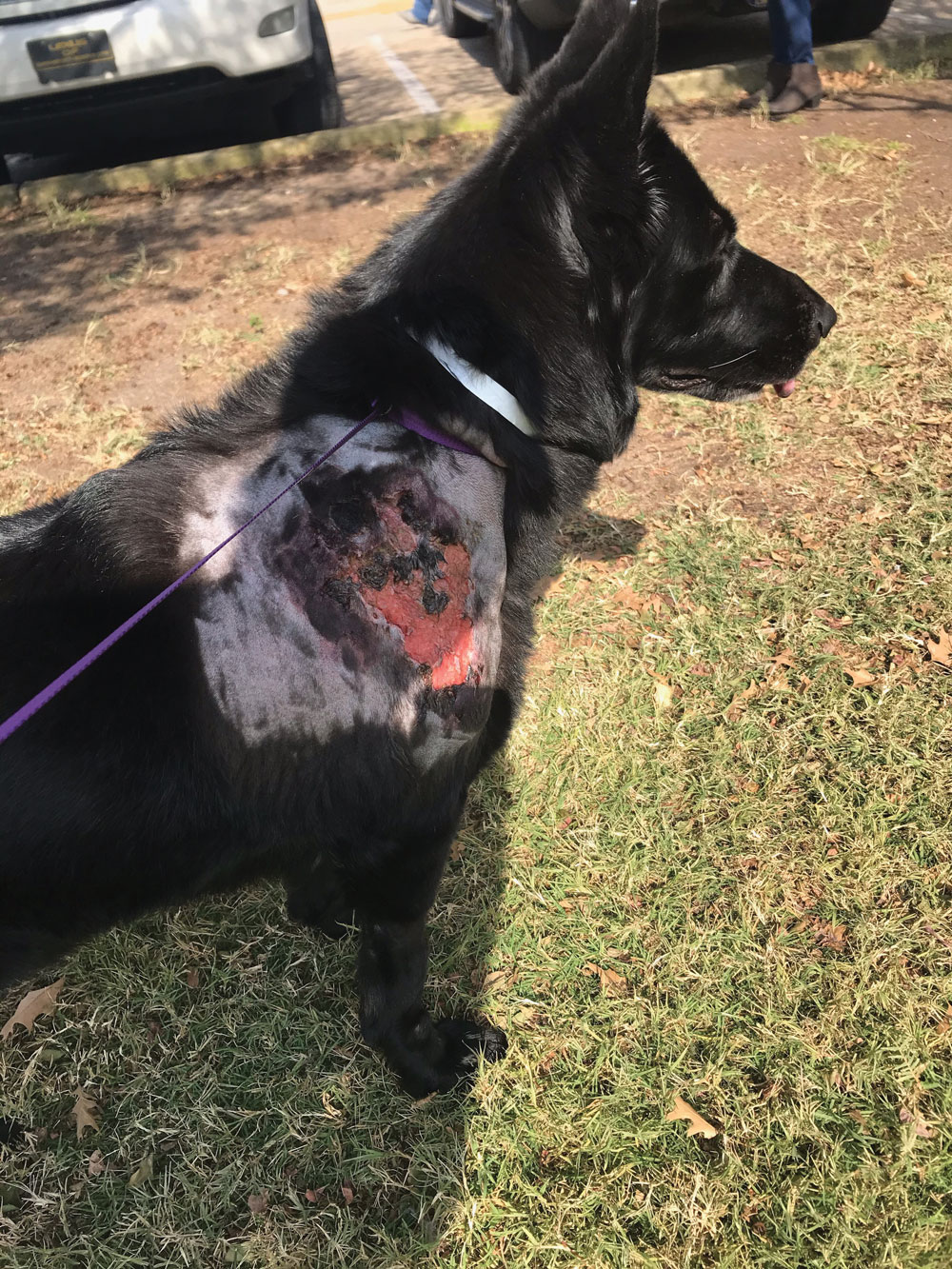
Shasta before surgery
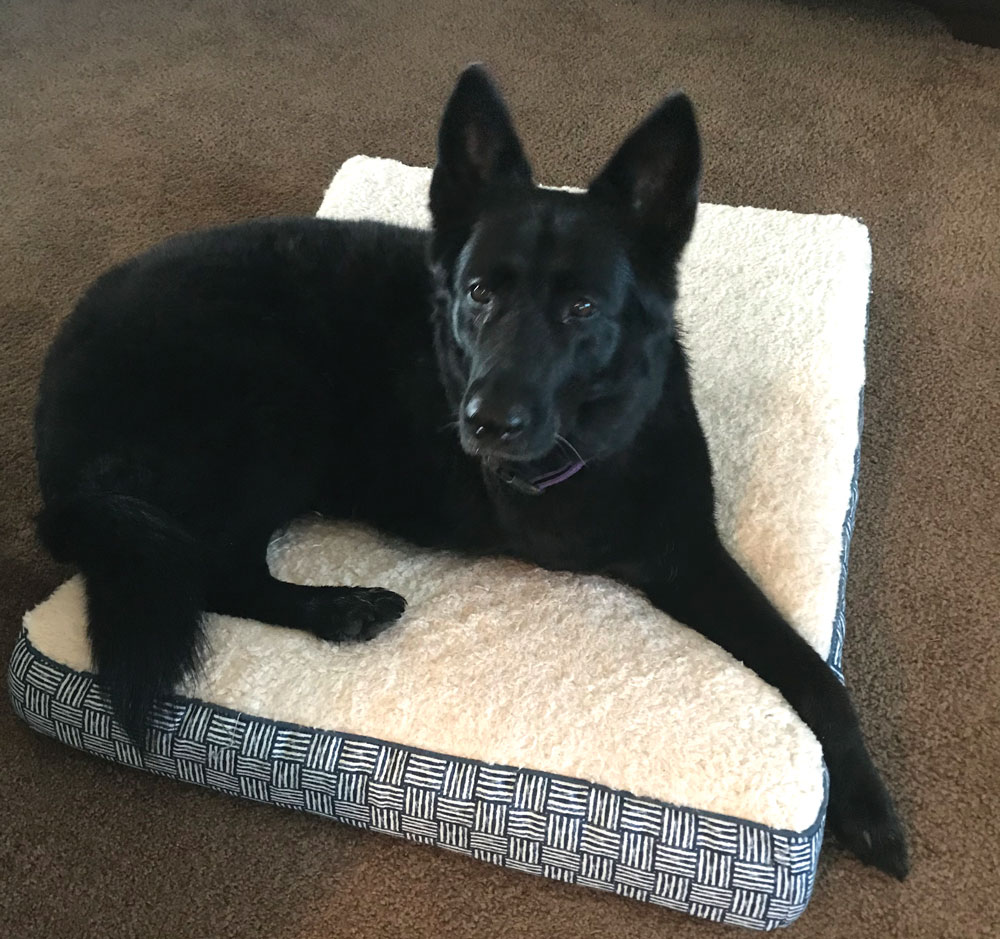
A healthy Shasta
Paula Prevot had always wanted a solid black German shepherd dog. In 2010, she found one and named her Shasta. The puppy was only nine weeks old when Paula brought her home from Missouri. Shasta grew into a healthy and happy dog who loved to guard the family’s front yard and sleep in her favorite chair in Paula’s bedroom. Then, at 10 years old, Shasta contracted what turned out to be a rare flesh-eating disease.
“It started with a very small puncture on the shoulder that looked like a snake bite in July of 2019. We treated it with several different antibiotics and topical ointments, but nothing helped,” Prevot said.
By the end of October, Shasta was diagnosed with pythiosis by Sandra Merchant, DVM, DACVD, professor emerita of veterinary dermatology. Prevot, who lives in Shreveport, brought Shasta to the University Veterinary Hospital for a consultation and met Dr. Merchant, who happened to be at the hospital for her semi-monthly rotation there. Pythiosis is a fungal-like infection caused by the aquatic mold Pythium insidiosum and occurs in dogs, horses, and humans. It is generally contracted when animals drink, stand, or swim in stagnant contaminated water. Prevot has a pond on her property and believes that’s where Shasta likely came into contact with this organism. However, her other dogs both swam in the same water and experienced no problems. Within three months, the lesion on Shasta had grown so huge that surgery was thought to be impossible.
“I fought it for months. It got worse. I felt so helpless. We were lucky we arrived at the hospital on a day Dr. Merchant was here in our city,” Prevot said. After the diagnosis was made, appropriate medicine was started with the hopes it would help Shasta. Some pythium infections do not respond to any therapy. Shasta’s infection initially responded, but then it worsened dramatically.
As Shasta’s health deteriorated, Prevot wondered whether euthanasia would be the kind thing to do. Shasta was referred to Michelle Woodward, DVM, DACVD, then assistant professor of veterinary dermatology at the LSU SVM, to utilize the hyperbaric chamber in an attempt to help treat the infection. While there, Dr. Woodward asked her colleague to evaluate Shasta to see if radical surgery would be feasible. Avery Bennett, DVM, DACVS, then professor of small animal surgery at the LSU SVM, determined that he could remove Shasta’s front leg and use the remaining shoulder skin to cover the gaping hole that would be left from the removal of the infected tissue. “Amputation was a hard decision. But it was the right decision because the lesion was so large. It was amputation or euthanasia,” Prevot said.
Shasta’s aftercare was overseen by LSU SVM alumna, Rachel McNair, DVM (LSU SVM 2015), through University Veterinary Hospital. Shasta developed a very resistant bacterial infection at her surgery site and a 105-degree fever. Dr. McNair started Shasta on daily injectable antibiotics until the bacterial infection had resolved and continued the medication for the pythium infection for another two months.
Now, 18 months later, Shasta is doing great, no longer takes medications, and has had no recurrence of the disease. She is back to her job of guarding the family’s yard. She’s treated like a princess in her family of LSU Tigers (Paula studied psychology and accounting, her husband studied architecture, and each of their four children studied at LSU, as well.).
“I was committed to help Shasta. We’re on the other side of the crisis. Every day, she’s doing better and better. I felt she was in good hands the whole time,” Prevot said.
Writer
Sandra Sarr, MFA
Communications Manager
Witter gives $175,000 for LSU SVM scholarship, clinical skills space
Published May 26, 2021

Hoover, Molly Patton, DVM intern, Laura Riggs, DVM, surgeon, and Big Brown Kitty (daughter of Kentucky Derby winner Big Brown), who Phil Witter eventually adopted.
Phillips C. Witter has made a gift to the LSU School of Veterinary Medicine of $175,000, which will allow the school to establish the Eleanor Connell Witter of Live Oak at Cedar Lodge Farm Scholarship. The first scholarship will be awarded in the fall of 2021. A $25,000 portion of his gift names the Garig–Connell–Witter Exam Room, where students move from the classroom into a clinical setting in the LSU SVM’s new Stephenson Pet Clinic. There, they conduct mock examinations and improve communication skills. The clinic is expected to open in early 2022.
“I have always wanted to do something to honor my mother and to help out the vet school,” Witter said.
He is grateful for the care his animals have received at the LSU SVM since the late 1970s. “When I started in the business, I had to haul horses all the way to Texas A & M and dogs to Auburn University Veterinary Clinic for treatment of complex issues. It’s a blessing to have the LSU vet school here,” he said.
Witter has brought many animals to the LSU SVM for treatment, including Hoover, a quarter horse then 18, who underwent life-saving emergency surgery. Horses have 70 feet of small intestine, and fully two thirds of Hoover’s had adhesions from a previous surgery, causing colic. Typically, no more than half of the small intestine can be removed successfully because it becomes hard for the horse to absorb nutrients. But, because Hoover’s remaining intestine was healthy, surgery was an option. Drs. Laura Riggs, Mustajab Mirza, and Molly Patton were clinicians on the case.
“I explained to Mr. Witter that it would be a long and complicated procedure. He decided he wanted to give Hoover a chance,” said Laura Riggs, DVM, Ph.D., DACVS, associate professor of equine surgery.
The April 2019 surgery on the 1,200-lb. horse took nearly four hours, during which he was under anesthesia.
Twenty-five blood vessels needed to be tied off and the intestine resectioned. With both Drs. Riggs and Mirza, plus others on the clinical team, they were able to work faster. Surgery involves three critical junctures: the surgery itself, recovery from anesthesia, and post-operative healing.
“I called Mr. Witter when Hoover was in the surgery recovery room. We weren’t certain Hoover would wake up. But he did wake up and stood up immediately, as horses must. Hoover has a strong will to live,” Dr. Riggs said.
Hoover remained in intensive care for 60 days. Now, at 20 years old, he is doing well.
“Mr. Witter’s animals are lucky to have him as a decision-making authority for their needs,” said Mustajab Mirza, DVM, DACVS, associate professor of equine surgery.
Another such complex case handled successfully by the LSU SVM was that of Witter’s half-Arabian mare, Beyond Compare, who underwent a resection of the colon.
“The love and dedication of everyone on the veterinary team showed for these animals is the inspiration for this scholarship,” he said.
Witter structured this scholarship so that the school could use it at the discretion of the dean and Student Affairs staff to best meet the LSU SVM’s mission-based needs over time.
“Phil Witter’s gift has given us the ability to address both current and unforeseeable needs well into the future. We are deeply grateful for his generosity, wisdom, and trust,” said Joel D. Baines, VMD, Ph.D., dean and Kenneth F. Burns Chair in Veterinary Medicine.
It could be said that Witter’s gift to help advance students’ study of veterinary medicine runs in his blood. Witter’s scholarship is named for his late mother, Eleanor Connell Witter, who established a scholarship in her father’s name at his alma mater, Vanderbilt University. Witter’s father graduated from McGill Medical School in Montreal and conducted respiratory studies on horses, including Man-O-War, a champion American thoroughbred racehorse, at Faraway Farm, adjacent to Poplar Hill Farm, in Lexington, Kentucky. The two met on a train traveling to New York. Witter’s father opened his first medical practice in Baton Rouge and was a general practitioner who made house calls in the area.
Both of his parents loved animals. Witter grew up on the family land where he currently lives, and it was filled with cats, dogs, working horses, and cattle. As a child, he learned to drive teams of horses and mules while sitting in the lap of an overseer. He started riding horses at age 4 on the Baton Rouge land that once spanned 1,800 acres, including what is now the I-10/I-12 highway split, once a virgin cypress swamp adjoining Burden Plantation. His land is now a 250-acre pastoral oasis surrounded by city.
Witter left home for Vanderbilt University, where he studied political science and economics, earning B.A. and J.D degrees. He briefly studied international law abroad and returned to Baton Rouge in the early 1970s. That’s when he began a business showing horses and cattle that invented a new direction for his family’s farm, launched a stellar career, and started his relationship with the LSU SVM.
Since he began keeping digital records, Witter has had 3,500 winning show horses in various national and regional events, including Western, country pleasure, English, driving, halter, and hunter. Witter now has about 60 horses, 300 cattle, and a scholarship and clinic room down the road at the LSU SVM, where he knows animals will receive excellent care.
“You see the kindness and caring and investment the veterinarians, students, interns, and residents put forth for the animals in their care. Anything I can do to help attract the best and the brightest to the LSU vet school and help those students when they really need it, I want to do,” he said.
Writer
Sandra Sarr, MFA
Communications Manager
In Times of Trouble, We’re Here for Each Other
Published May 28, 2021
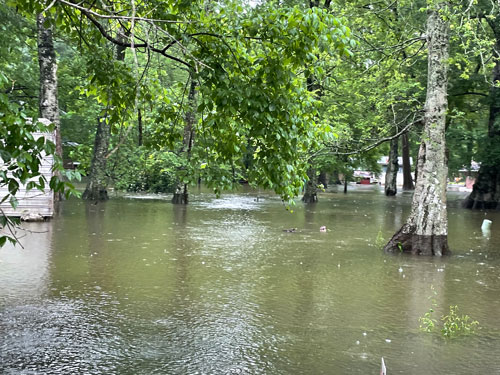
As floodwaters continued to rise and LSU closed on Tuesday, May 18, equine surgeons Drs. Mustajab Mirza and Britta Leise took to the road down Highway 30 to check on colleagues and clients who live along a stretch of road in St. Gabriel, just south of Baton Rouge, known for its ranchettes, horse pastures—and flooding. In 2016, historic flooding in south Louisiana affected many LSU SVM faculty, staff, and students.
The evening prior, Dr. Mirza had met Dr. Cherie Pucheu, Dermatology Service chief, at the SVM to help her unload her horses and goat and get the animals safely settled.
“Dr. Pucheu moved her horses before the water rise became an issue,” Dr. Mirza said.
Dr. Pucheu recalls that SVM people were there for her in 2016, as well, helping her sandbag her house.
“At that time, Dr. Mirza advised me to move my horses and goat before the water got higher. He was right, and I’m glad I took his advice then. I remembered that advice and moved them early this time as well,” Dr. Pucheu said.
He also checked in with Dr. Mandi Lopez, professor & director of the Laboratory for Equine & Comparative Orthopedic Research, to see how she and her animals were faring.
“I appreciated him being in touch to make sure we were alright. We’re still dealing with the water,” Dr. Lopez said.
Along the flooded road, Drs. Mirza and Leise checked on SVM clients, including Dick Fanguy, farrier; Susan Biehl, barn manager; Wesley Self; Gaitway Therapeutic Horsemanship Farms; and Dawn Kelly, supervising technician, Equine and Nuclear Medicine Imaging, and her daughter Nicole.
“It’s nice to know that our work family cares,” said Dawn Kelly, who remains displaced by recent floodwaters. She recalls Drs. Mirza and Anna Chapman helping her during the 2016 flood, along with Torri Collins, small animal technician, who trailered Kelly’s stranded horses to her own property to keep them safe.
Fanguy of Country Bayou Stables was out of town when the flooding occurred. His wife, Susan, was on site.
“When Dr. Mirza pulled into the driveway, it meant the whole world to us. Knowing I was gone, he physically came to our place to make sure we were okay,” Fanguy said.
“When people see a familiar face, it reminds them that they are not alone and we’re here for them,” Dr. Mirza said.
He is a member of the LSU SVM’s Disaster Training and Response Program in partnership with the Louisiana State Animal Response Team (LSART).
“When the flooding comes, it’s difficult to get to people and animals. You can’t put a horse in a boat,” said Dr. Mirza.
He believes that taking a wait-and-see approach to evacuation is tough on people and risky. High water can conceal fences and contain debris and contaminants.
“These situations are emotionally taxing, particularly this year. People are mentally fatigued by flooding, the pandemic, hurricanes because there’s no known and lasting relief in sight. They’re emotionally numb. This is true globally,” Dr. Mirza said.
That numbness can impact decision making in crisis situations. And that’s why being a member of a caring community like the SVM can be comforting and helpful in times of trouble.
“We look out for each other, and that’s part of what makes us great,” Dr. Pucheu said.
Memories of the 2016 flood and other disasters came back for Dr. Mirza, who recalled many of the SVM helpers: Ky Mortensen and Drs. Chance Armstrong, Laura Riggs, Dan Burba, Britta Leise, Rusty Moore, Dennis French, Rebecca McConnico, Frank Andrews, Wendy Wolfson, Martha Littlefield, Renee Poirrier, Rose Baker, Heidi Banse, Matt Welborn, Clare Scully, and others who offered assistance during natural disasters.
“Dr. Brandy Duhon, in her leadership role with LSART, manages most, if not all, disasters when animals are in harm’s way. For me personally, I was pulled out of 2016 flood waters up to my chest and rising by Dr. Chapman. I was trying to get to some birds. Drs. Colin Mitchell and Chuck McCauley offered to fix my place after the 2016 flood. My dog and I were provided shelter by Cindy Meeker. These things meant a lot to me,” Dr. Mirza said.
“When tough times come, our SVM community members show up for each other, taking our mission to protect to a personal level when it means the most,” said Dean Joel Baines.
Contact
Sandra Sarr, MFA
Communications Manager
Dog Bitten by Snake on Daily Walk Successfully Treated at the LSU Vet School
Published July 12, 2021
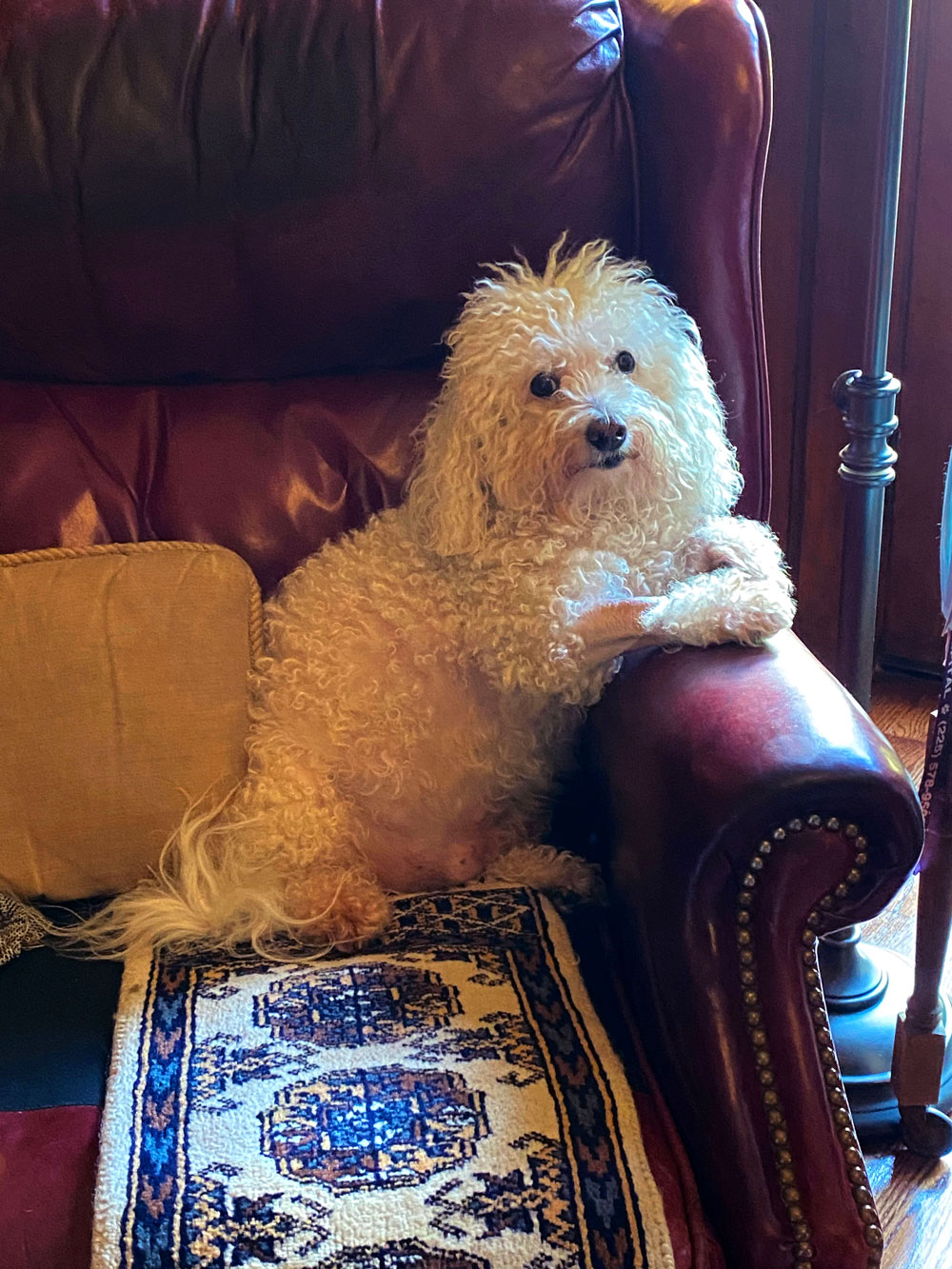
In late May, Oliver, a Bichon Frise, and his best friend, Larry, set out on their walk through the Garden District as they did each morning for all of Oliver’s 13 years. However, this particular day turned out to be anything but usual.
While leashed and trotting ahead of Larry on the sidewalk, Oliver suddenly jumped and yelped. His began frothing at the mouth, tongue hanging. Larry got him home, where the dog gulped a whole bowl of water and thrashed on the floor, crying out in pain. Larry called the Garden District Animal Hospital and their regular veterinarian, Andrea Andersen, DVM (LSU SVM 2008), told him to take Oliver straight to the LSU School of Veterinary Medicine.
“They were expecting us when we pulled up. Two seconds after we arrived, it looked like a triage scene from MASH. They came running, grabbed Oliver, and took him inside the hospital. Someone yelled that a team member would be out soon to update me,” said Larry.
“He came in as a respiratory distress case. We determined his chest and lungs were clear. He was in pain, his heart rate was up, he was restless and anxious. He had hives all over his belly. We could see two puncture wounds on his left forelimb,” said Mallory Horridge, DVM, emergency and critical care resident, who palpated his legs, found some swelling, and got his pain under control.
About an hour after Oliver was whisked into the hospital, Dr. Horridge informed Larry that they’d gotten Oliver stabilized. He instructed her to do whatever they needed to do to treat Oliver.
Larry waited in the LSU SVM parking lot as Oliver was assessed, diagnosed, and treated. After physical examinations and a series of tests, Oliver’s clinical team diagnosed the dog with a snake bite.
Oliver was transferred on anti-histamines and pain medications to the LSU SVM’s Internal Medicine service, where Tifini Batts, DVM, MSPH, internal medicine resident, assessed him further. The Internal Medicine team discussed the case, did blood work, and took radiographs of his forelimb to ensure there was no bone injury and radiographs of the chest to rule out any underlying respiratory disease.
“Generally, there is pronounced swelling and pain at the site of a bite within minutes. Getting the animal to a veterinarian quickly is important. The sooner we see them, the more we can do to help them. Assessment is key,” said Ryan Smith, DVM (LSU SVM 2009), DACVECC, assistant professor of emergency and critical care.
Snake venom can cause animals to go into shock, extensive tissue damage, and blood coagulation problems. Small dogs and puppies are particularly susceptible to the effects of snake venom. If there are signs of a systemic reaction, antivenom is administered. Antivenom is an antibody product that can neutralize toxins. If injected quickly after a bite, it can save lives, limbs, and tissue.
“The decision to administer antivenom is not made lightly because it is not a benign agent. It is produced using a purified serum from other species, such as horses and sheep. It is a foreign substance to a dog, and the dog could develop a reaction,” Dr. Smith said.
The LSU SVM sees dozens of snake bite cases per year, but the mortality rate is low, about 4-5 percent.
“It’s always snake season in Southern Louisiana, though we see more cases in warmer months,” Dr. Smith said.
Most snake bite effects stay localized, as in Oliver’s case. He received fluids, pain management, and other supportive care.
“I was frantic when I brought him in to the vet school. Oliver does not leave my side. He sleeps on my bed. I haven’t taken one vacation if I couldn’t take him with me,” said Larry, who first brought Oliver’s Twisted Delight (his full name) home when he was just eight weeks old and Larry was recovering from cancer surgery.
According to Larry, several clinicians remembered Oliver from five years ago, when the dog suffered a spinal injury and was cared for at the LSU SVM. He underwent six months of crate rest, and during that time, Larry had to carry Oliver whenever he needed to go outside. “One morning, Oliver started walking again, and then he took off running,” Larry said.
Even though Oliver has proven to be resilient, Larry doesn’t take chances with Oliver’s health. They have altered their morning routine, crossing streets on walks when they encounter areas that are dense with growth where snakes could hide. Larry remains vigilant while enjoying walks through the neighborhood with his best friend.
“If I hadn’t had Oliver during quarantine, I don’t know if I would’ve made it through,” Larry said.
Contact
Sandra Sarr, MFA
Communications Manager
Routine vet visit reveals tumor; surgery, radiation avert amputation
Published August 26, 2021
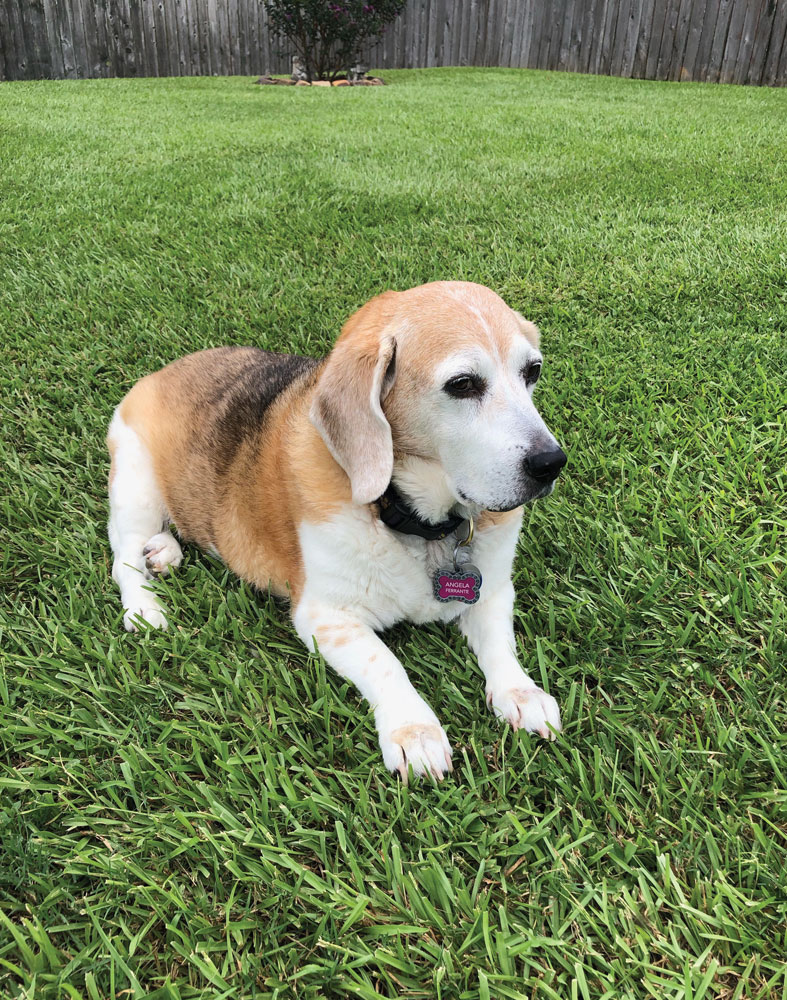
Marion Ferrante got more than she bargained for when she took Angela, her son Darren’s beagle, then 11 years old, to her veterinarian for a nail trim. During this routine visit, Aaron Hood, DVM (LSU 1997), of Hood Veterinary Hospital in Denham Springs, discovered a large growth on the inside of Angela’s right back leg. Tests revealed a cancerous tumor.
Two weeks later, Angela's veterinarian attempted to surgically remove the tumor. However, he could remove only a portion because it had spindle-shaped cells that intertwined with Angela’s tissues and muscles.
“Dr. Hood suggested that we take Angela to LSU because they have clinical trials with animals diagnosed with cancer, and he felt they could help this complex case,” Marion said.
The Ferrantes were committed to getting Angela the best care possible. Angela had been a part of their family since they brought her home at eight weeks old.
“Dr. Jayme Looper and Dr. Jennifer Merkle from LSU reviewed her case and we received a call saying there was hope. They turned out to be Angela’s angels, too,” Marion said. Dr. Looper (LSU 1997) is a professor of veterinary radiation oncology and a board-certified oncologist, and Dr. Merkle completed her radiation oncology residency at LSU in July 2021.
Surgeons at the LSU Veterinary Teaching Hospital performed another surgery on Angela. She was diagnosed with a Grade 2 soft tissue sarcoma.
“We were scared. Everybody at LSU vet hospital was very supportive and kind during such a traumatic time in our lives. They made sure we understood our options,” Marion said.
In September 2019, Angela began 19 rounds of radiation therapy and completed them in October. She wore an inflatable e-collar to keep her from irritating the radiated areas inside her back leg. Angela returned to LSU for a follow-up visit in late October. Her clinicians were pleased with the healing of the irradiated areas.
Medical workups done prior to radiation therapy are very thorough. In fact, tests revealed that Angela has only one kidney.
“That was a surprise,” Marion said.
The treatments combined with surgery allowed Angela to avoid a leg amputation.
“We are so grateful she’s still with us and that we have extra time with her,” Marion said.
Angela, now 13, has intermittent lameness in her right rear limb, and Marion notices her back legs are occasionally weak.
“But we know Angela is now feeling so much better because she has started playing with her toys again and vocally letting us know it’s time to feed her,” Marion said.
Contact
Sandra Sarr, MFA
Communications Manager
Good Samaritan-Rescued, Chemically Burned Dog Treated at LSU Vet Med and Adopted by Student
Published September 23, 2021

Jasmine Walker was driving southbound on River Road on a hot August day when she noticed the cars ahead of her swerving. In the middle of the road, she saw a dog and stopped to help.
“I have never seen an animal in such bad shape. Her ear looked burned away, and there was puss oozing from her body. I could see she was in pain. I opened my passenger’s side door. She tried to climb in but needed my help,” said Walker, an LSU senior majoring in elementary education.
Walker noticed a kennel nearby on the side of the road and saw that it contained old dog food inside.
“The dog, just a puppy, a pit bull terrier, was so afraid. Yet, she trusted me. She curled up next to my feet while I was driving to get her help,” Walker said.
Initially unsure what to do with the severely injured dog, Walker started to drive home when she remembered she could call the LSU School of Veterinary Medicine. She brought the dog to the school for emergency treatment.
“Two ladies ran out to meet me at my car and took the dog inside,” Walker said.
Rhiannon Hodges, a fourth-year veterinary student, was on the Small Animal Emergency Services rotation when the Good Samaritan called. Hodges was one of the people who rushed outside to meet Walker.
“The dog was on the floorboards wagging her tail. She licked me on my face, and my heart was smitten,” Hodges said.
With chemical burns covering 70 percent of her body, the clinical team, including Emergency Services, Dermatology, and Surgery, collaborated to help her heal with daily hydrotherapy, topical creams, pain medication, and antibiotics.
“It appears someone intentionally tortured her. Any chance I got, I would go to her in the ICU unit and help the excellent nurses care for her,” Hodges said.
Because the dog was homeless, the Companion Animal Alliance assumed ownership of her.
“She let me know she was willing to fight. She was so full of life,” Hodges said.
Hodges chose to foster the dog through CAA and named her Juno, after the Roman goddess. Recently, Hodges decided to adopt Juno and provide her a permanent home.
“My favorite part of the day is walking into the vet school and seeing her greet her fan club,” said Hodges, who dresses Juno in onesies to protect her skin from the sun and infection.
“It means a lot to me that Juno is shown nothing but love here at the vet school—especially since she wasn’t shown love before,” Hodges said.
With only 10 percent of wounds left to heal, Juno’s prognosis is good. Her skin is expected to fully heal, though it is unclear whether her fur will grow back.
“It’s heartwarming to know we have an entire team behind us. Juno didn’t have that before. Now, she will for the rest of her life. She’s a Tiger now. Her stripes just look a little different than other tigers’,” Hodges said.
The Good Samaritan who stopped to help Juno is thrilled to know that she is healing and has a home of her own.
“It is so good to know that we have a place to bring an injured or sick animal. I couldn’t help her, but the vet school could help her,” Walker said.
Each year, more than 300 cases of animals in need of emergency treatment are brought to the LSU School of Veterinary Medicine. These animals do not have owners but are brought to our 24-hour emergency facility by Good Samaritans, like Walker, who care deeply for animals in need. The school provides emergency services, critical care, testing, and ICU to these animals.
The cost of treating and caring for these ownerless animals approaches $70,000 per year, a cost absorbed by the school in a commitment to heal animals as part of its mission.
If you would like to contribute to the Good Samaritan Fund at LSU Vet Med, please go to lsufoundation.org/givetovetmed and choose the Good Samaritan Fund.
Writer
Sandra Sarr, MFA
Communications Manager
Tending to the health of the herd
Published October 28, 2021
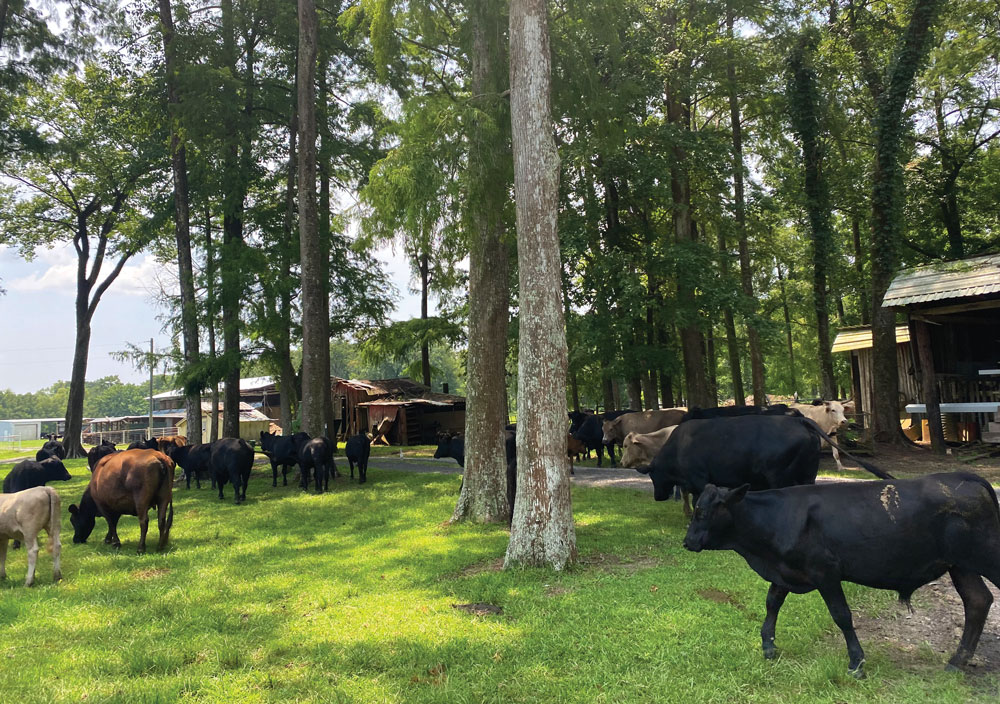

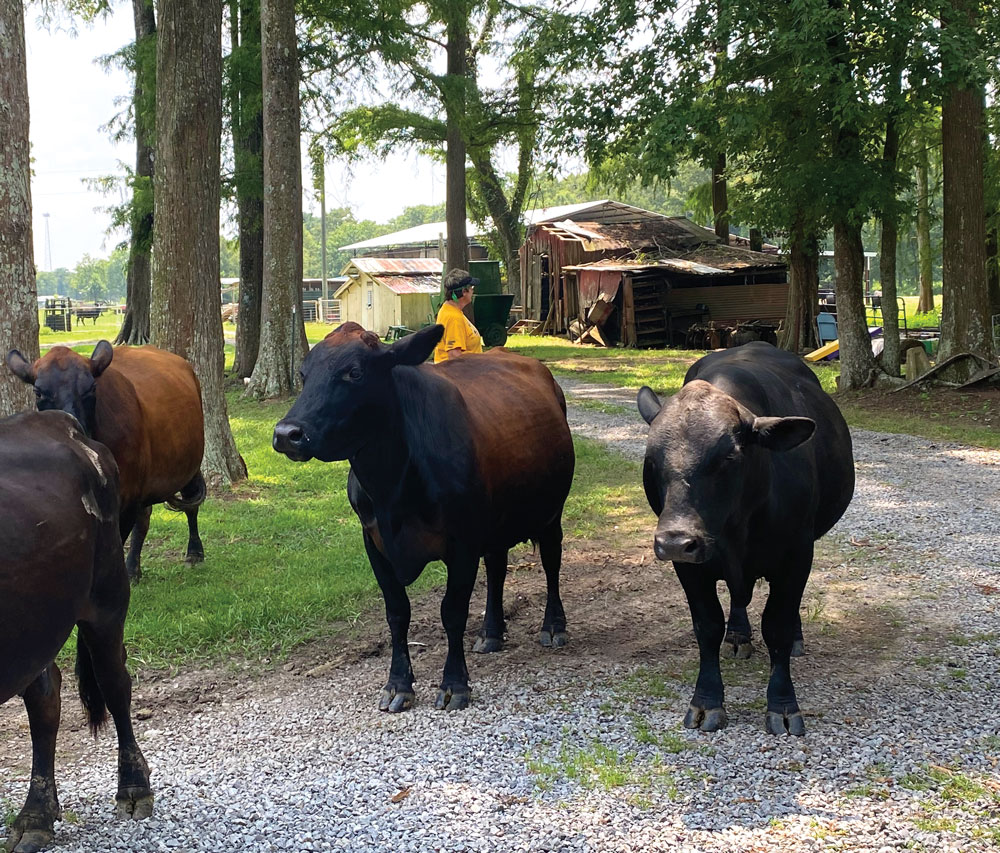
30-year LSU Vet Med client secures best care for cows
It was late evening when rancher and business owner, Lisa Scrantz, discovered that her Holstein bull, Hank, had caught his back leg in a culvert. Hank’s leg had snapped, and Scrantz was unable to free him, particularly since a Holstein bull can stand six feet tall and weigh up to 2,500 pounds. Scrantz called Mustajab Mirza, DVM, DACVS, LSU School of Veterinary Medicine large animal surgery specialist. Dr. Mirza drove 50 minutes from Baton Rouge to Scrantz’ Krotz Springs, Louisiana, ranch situated alongside Bayou Courtableau. An associate professor at LSU Vet Med, he brought students with him to help and teach. They assessed the bull’s open fracture of the tibia and determined the extent of his injuries, which required that he be euthanized.
“Dr. Mirza once even came one evening on his day off when a cow was prolapsing (an abnormal repositioning of an organ). He is a fabulous and compassionate veterinarian. I enjoy working with him,” said Scrantz.
Scrantz, who is a partner in an accounting firm in Baton Rouge, is a 30-year client of the LSU Large Animal service. From calves born prematurely and needing plasma transfusions to cows requiring end-of-life care, Lisa Scrantz knows she can count on LSU Vet Med veterinarians to provide excellent lifelong care for the herd that lives on her 300-acre ranch.
“LSU is putting excellent veterinarians into the world,” Scrantz said.
Scrantz has donated a substantial amount of equipment for anesthesia and food animal services to the LSU’s Large Animal Clinic. She also plans to make an estate gift that will provide funds for student scholarships and other purposes. She appreciates the learning opportunities she’s received observing LSU Vet Med clinicians and wants to help future veterinary students.
“I’ve been fortunate and successful in my life,” she said, though her career trajectory had its twists and turns. She attended Southeastern University pursuing an education degree. She later transferred to LSU to study petroleum land management. She worked on oil rigs as a roughneck, working 12-hour shifts, seven days on and seven days off. Roughnecks perform activities such as setting up and maintaining oil rigs, preparing the area for drilling operations, assembling pipes, and driving trucks. She made another career shift when she began working for James “Blondie” Bennett of Bennett & Bennett Associates Inc., a local tax and accounting firm. Lisa began LSU courses in accounting and taxation. In 1987, Bennett retired and sold his business to Lisa. She became an enrolled agent specializing in taxes and representing clients before the IRS.
“It helps my sanity to check on my cows and get on a tractor after work,” she said.
Over the years, Scrantz and Dr. Mirza have become friends. The two once took a four-wheeler and chased a cow through the woods for more than an hour to catch her so Dr. Mirza could examine her.
“She’s constantly working to improve her ranch. She knows how to operate every piece of equipment,” Dr. Mirza said.
“If I can’t load up a cow due to its immobility, I call LSU, and they come,” said Scrantz, who commutes weekdays from Krotz Springs to her Baton Rouge accounting firm located on Jefferson Highway in Baton Rouge.
“She takes excellent care of her animals. She probably has the oldest living cow in the state of Louisiana. If I were a cow I’d want to live on her ranch,” Dr. Mirza said.
When a two-day-old calf named Buddy wouldn’t suckle and was becoming weak this summer, Scrantz wrapped him up, put him in her back seat, and brought him to the LSU Large Animal Clinic. Matt Welborn, DVM (LSU 1987), professor of food animal medicine, examined the calf, administered a plasma transfusion, and prescribed a special bottle-feeding regimen. The calf is thriving and growing.
“If you’re in tune with your cows and keep a careful watch on them, they trust you and know you are trying to help them,” she said.
“Managing a herd of cows is harder than managing a group of people,” Dr. Mirza said.
When Scrantz was bushhogging one day, she saw a cow starting to give birth.
“As I watched that baby being born, tears came to my eyes. I watched the mama lick it, and the calf wobbled to get to its feet and stand up. How beautiful it is to see life being brought into the world. It’s a joy and a miracle,” said Scrantz.
She believes that her cows let her know when something is wrong. Like the time when Scrantz was on a tractor distributing hay and encountered a cow on the road mooing. She got off the tractor and followed the cow to a wood pile. Scrantz spotted a newly born calf that was stuck.
“I worked my way into the pile and eventually got it out. The mama licked the calf, walked ten steps, stopped, looked back, and shook her head at me. I know she was thanking me,” she said.
“The vets and their students at LSU know how much I love my animals,” Scrantz said.
The LSU Food Animal Health Management group is led by board-certified veterinary specialists. We also have technicians, caretakers, office personnel and veterinary students who provide comprehensive, advanced medical, surgical and reproductive care for individual ill and injured farm animals in the hospital setting as well as herd health and individual care for animals on the farm. This care is provided 24 hours a day, seven days a week, 365 days a year, including nights, weekends and holidays.
The hospital is staffed by additional specialists in anesthesiology, cardiology, ophthalmology, radiology, dermatology, oncology, and clinical pathology. These specialists are always available for consults to our field service clinicians.
LSU Vet Med clinicians provide compassionate and leading-edge care for all farm animals while providing excellent and timely service. To contact the LSU Large Animal Clinic, call (225) 578-9500.
Writer
Sandra Sarr, MFA
Communications Manager
LSU Vet Med provides specialized clinical training for students from other veterinary schools across the country and beyond
Published November 16, 2021

Each year, the LSU School of Veterinary Medicine partners with other veterinary schools and colleges to provide their students with expert clinical knowledge in a setting that offers services such as oncology, cardiology, dermatology, integrative medicine, shelter medicine, equine, ophthalmology, emergency and critical care, theriogenology, and wildlife medicine.
Nicholas Linzner, a 2022 Doctor of Veterinary Medicine candidate at Western University of Health Sciences, based in Pomona, Calif., completed a month-long externship in October at LSU Vet Med, where he obtained clinical experience that expanded his knowledge in radiology and exotic animal medicine and more.
“My externship experience was unlike anything I could get at my home campus, which doesn't have the space to provide so much exposure in one location. At LSU Vet Med, I got the hands-on experience I needed—knowledge targeted to my career goals,” said Linzner.
Linzner learned refined radiographic positioning and interpretation techniques, and how to apply them to equine and exotic animal medicine. He found the broad exposure to cases most beneficial, for example, positioning horses for CT scans and ultrasound procedures and working with anesthesiologists. He took on-call emergency shifts where he was on standby if radiographs were needed for emergency cases. Doing so involved hourly checkups on patients, helping to stabilize them, and administering medications. Also among the cases he was involved in were animals hit by cars and a horse with a tooth abscess needing radiographs to help guide the medical procedure.
“I was able to talk with residents about the cases, and they included me in rounds to observe. LSU has so many knowledgeable staff and faculty and access to excellent equipment and effective techniques,” Linzner said.
Linzner discovered a passion for diagnostic imaging through the summer research program at his university, where he utilized CT scans to create 3D-printable splints for exotic avian species.
“After graduation, I plan to pursue a residency to become board-certified in radiology. My goal is to enroll in a residency program that will allow me to develop this research for other exotic animals while becoming a skilled specialist. I feel like I’m well on my way,” Linzner said.
LSU Vet Med currently has two students doing externships in Exotics. One is from Texas A&M and the other is from the University of Puerto Rico. Two additional students, one from the University of Georgia studying Radiology and one from Mississippi State University studying Small Animal Emergency and Critical Care.
LSU Vet Med: Bettering lives through education, public service, and discovery
The LSU School of Veterinary Medicine is one of only 32 veterinary schools in the U.S. and the only one in Louisiana. We are dedicated to improving the lives of people and animals through superior education, transformational research, and compassionate care. We teach. We heal. We discover. We protect.
Writer
Sandra Sarr, MFA
Communications Manager
Native American Heritage Month Student Spotlight: Kaela Chisholm Turner
Published November 22, 2021
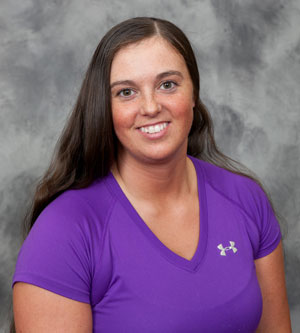
Kaela Chisholm Turner

Jesse Chisholm
In honor of Native American Heritage Month, we spotlight Kaela Chisholm Turner (Class of 2022), whose Cherokee heritage includes her fourth-great grandfather, Cherokee trader Jesse Chisholm, namesake of the Chisholm Trail originating in Texas and ending in Kansas and used during the late 19th century to drive cattle overland.
“He traded between white settlers’ villages, traveling according to seasons, as Plains Indian tribes did. He was known for his ability to bridge differences between Native Americans and white settlers,” said Kaela, a fourth-year veterinary student from Ramona, Oklahoma.
Kaela’s family is among the last living descendants of Jesse Chisholm, whose contributions to the American West are celebrated at the Chisholm Trail Heritage Center in Duncan, Oklahoma.
Kaela is an enrolled member of the Cherokee Nation and has a Certificate Degree of Indian Blood (based on ancestors of Indian blood who were enrolled with a federally recognized Indian tribe, according to the Bureau of Indian Affairs) and Cherokee Nation Voter ID card. With Cherokee ancestors on both her mother’s and father’s sides of her family, she grew up participating annually in Cherokee festivities and activities designed to teach the children about their Native American heritage, including powwows, cultural dancing, cooking, and language classes.
She shared that the word for Cherokee is Tsa-la-gi and that each letter represents a syllable. The Cherokee syllabary was invented by Sequoyah, of the Cherokee Nation, in the late 1810s and early 1820s as a means to write the Cherokee language.
“One thing I love about my tribe is that we have stories about Earth, seasons, and patterns that often revolve around animals. Growing up with these stories brought a sense of awe and a love of animals,” Kaela said.
She has known since she was eight years old that she wanted to be a veterinarian. She grew up around cattle on her maternal grandparents’ ranch. It was there that she put out hay, fed, castrated, and even pulled a calf when the birth became difficult. Her love of rodeo came from her uncle, who was a bull rider.
“My great grandmother would take me to heritage sites near the tribal seat at Tahlequah, Oklahoma. She took me to swim in a creek no matter how cold it was--a good memory, too,” Kaela said.
“How the Milky Way Came to Be” is one of Kaela’s favorite stories, which you can read here. “I like it because it is one way of putting everything in creation in its place,” she said.
Lately, her veterinary studies occupy most of her time, but she has attended the inter-tribal Coushatta Powwow in Kinder, La., where the culture is celebrated through dance, song, arts, and food. She and her husband have land in Mittie, La., near DeRidder, and look forward to living on a moderately sized farm with several horses and cattle after she graduates in 2022. Her career plans include a mixed-animal practice, although her passion is cattle.
What is one thing she would like non-Native American people in the U.S. to understand about her culture? She pauses for a moment and recalls when a Native American boy was held down at school by non-Native American classmates who cut off his braid. “There is no reason to disrespect someone because they look or act different from you. Everyone needs to understand that there are different cultures and none of them are right or wrong.” she said.
Native Americans are often overlooked as a minority group in her experience. “Our tribes were stewards of the land before immigrants came along. This land was ours before it was anyone else’s. We are often forgotten when mainstream institutions contemplate issues, be they environmental, cultural, or otherwise. I want to see that change,” she said.
LSU Vet Med: Bettering lives through education, public service, and discovery
The LSU School of Veterinary Medicine is one of only 32 veterinary schools in the U.S. and the only one in Louisiana. We are dedicated to improving the lives of people and animals through superior education, transformational research, and compassionate care. We teach. We heal. We discover. We protect.
Writer
Sandra Sarr, MFA
Communications Manager
Native American Heritage Month Student Spotlight: Lindsey Newton
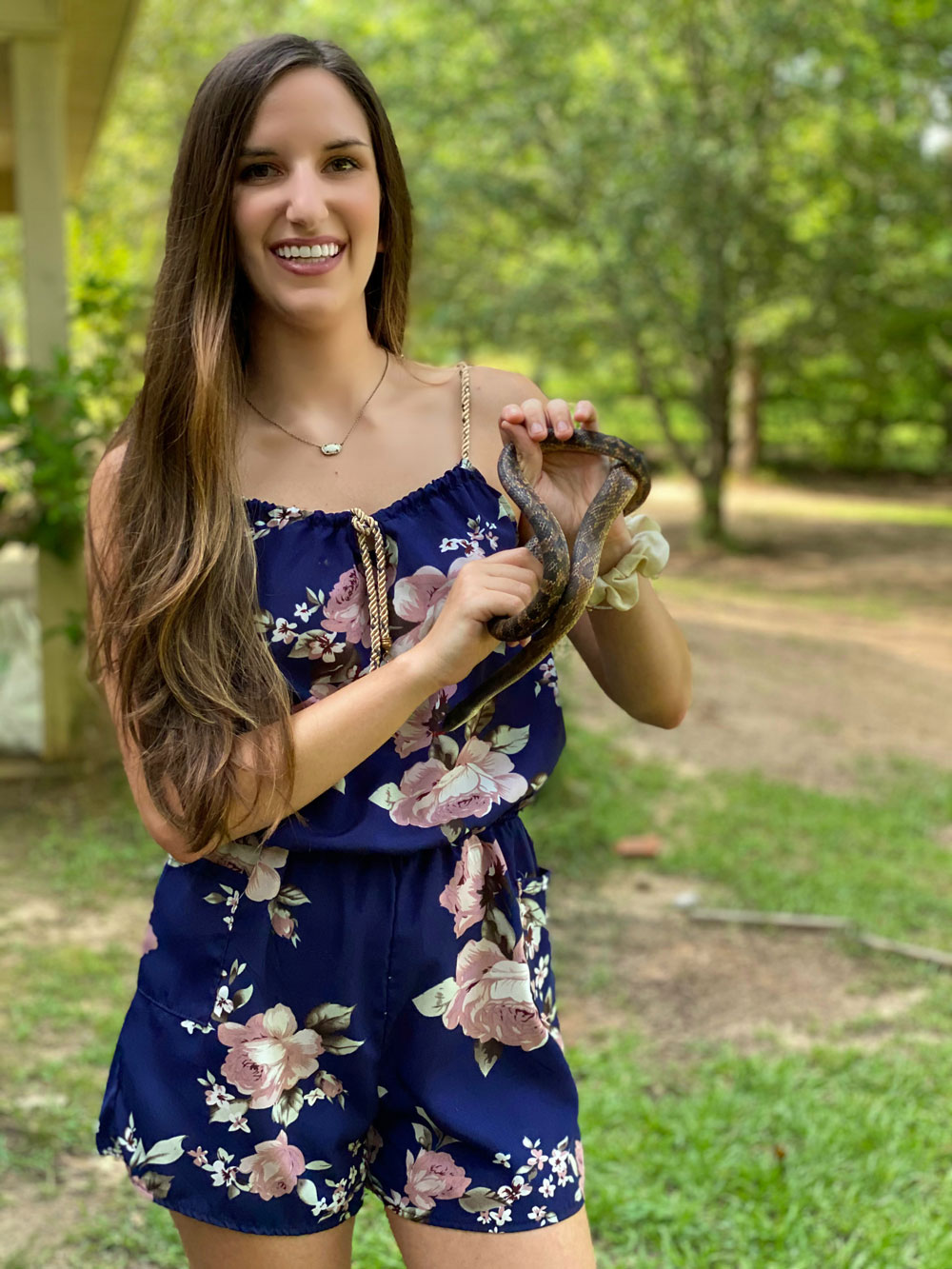 Published November 23, 2021
Published November 23, 2021
In honor of Native American Heritage Month, we spotlight Lindsey Newton, an enrolled member of the Four Winds Tribe, Louisiana Cherokee, based in Rosepine, La. Lindsey grew up in rural Dry Prong, La., within the Kisatchie National Forest, 22 miles north of Alexandria.
As a child, connecting with nature was her family’s form of therapy. If times were challenging, her mother would ask, “Have you gone outside, put your bare feet on the earth, walked through the forest?”
Lindsey grew up with an awareness that she had Native American ancestry, but it wasn’t until she was 17, when her family conducted genealogic research, that ancestry confirmed she was of Four Winds Cherokee heritage.
“Suddenly, I understood why nature was sacred to us. I had a feeling of ‘Oh, this is why.’ Knowing my Native American heritage gave me a sense of belonging,” said Lindsey, a second-year student at LSU Vet Med.
As an undergraduate student, she worked for two summers as an avian field technician for the U.S. Forestry Service in Kisatchie National Forest and presented research at the Louisiana Association of Professional Biologists 2019 Symposium. Her LSU degree in wildlife biology was a planned step toward veterinary school, a life-long goal.
When Lindsey was in preschool she wrote “in chicken scratch handwriting with misspelled words,” I want to be a veterinarian. She believes her career choice is interwoven with her Native American heritage rooted in nature.
Lindsey has always lived her life with an understanding of the interconnectedness and unity of all life. “There is no part of the ecosystem that can function without the other parts of the whole,” she said.
While she didn’t have an opportunity to partake in Native American ceremonies and festivities when she was young, she enjoys seeing her niece and nephew, children of her brother and his Choctaw wife, do traditional dances and fancy dances with shawls.
Lindsey wants to be a role model for Native American children. She hopes to do outreach events through The VOICE Club at LSU Vet Med, which celebrates multiculturalism within the profession of veterinary medicine and works to promote the importance of cross-cultural awareness. Lindsey serves as treasurer and fundraising chair of VOICE.
Positive role models can make a difference for young Native Americans and bolster self esteem, particularly when difficult comments are aimed at them. In Lindsey’s experience, these comments often come in the form of bad jokes. “I was told recently, ‘You don’t look like you’re Native American.’ Some people think we all wear moccasins and feathers in our hair. They don’t see us as contemporary people living our lives,” she said.
Looking ahead at when she becomes a Doctor of Veterinary Medicine in 2024, she foresees a career in wildlife or zoo conservation medicine. “Conservation medicine also involves habitat restoration because endangered species that are so precious to us have their habitat threatened at alarming rates. I want to make a difference somewhere where I can be connected to wildlife,” she said.
LSU Vet Med: Bettering lives through education, public service, and discovery
The LSU School of Veterinary Medicine is one of only 32 veterinary schools in the U.S. and the only one in Louisiana. We are dedicated to improving the lives of people and animals through superior education, transformational research, and compassionate care. We teach. We heal. We discover. We protect.
Writer
Sandra Sarr, MFA
Communications Manager
Competitive Edge
How the demands of undergraduate student-athlete life prepared these veterinary students for the rigors of learning veterinary medicine
Published December 14, 2021
We spoke with several LSU School of Veterinary Medicine students about how being a student-athlete in undergraduate school prepared them for the rigors of veterinary school. What they told us confirms the research: Participation in collegiate sports gave them an academic advantage.
“Effects of Student Athletics on Academic Performance,” an article in the Journal of Undergraduate Research, offers one example of research that concludes, “These athletes performed better in the classroom, developed impressive time-management skills, and felt motivated to complete their degree.”
Our students shared some of the ways in which collegiate sports instilled lessons that helped them tackle getting admitted to and succeeding in veterinary school.
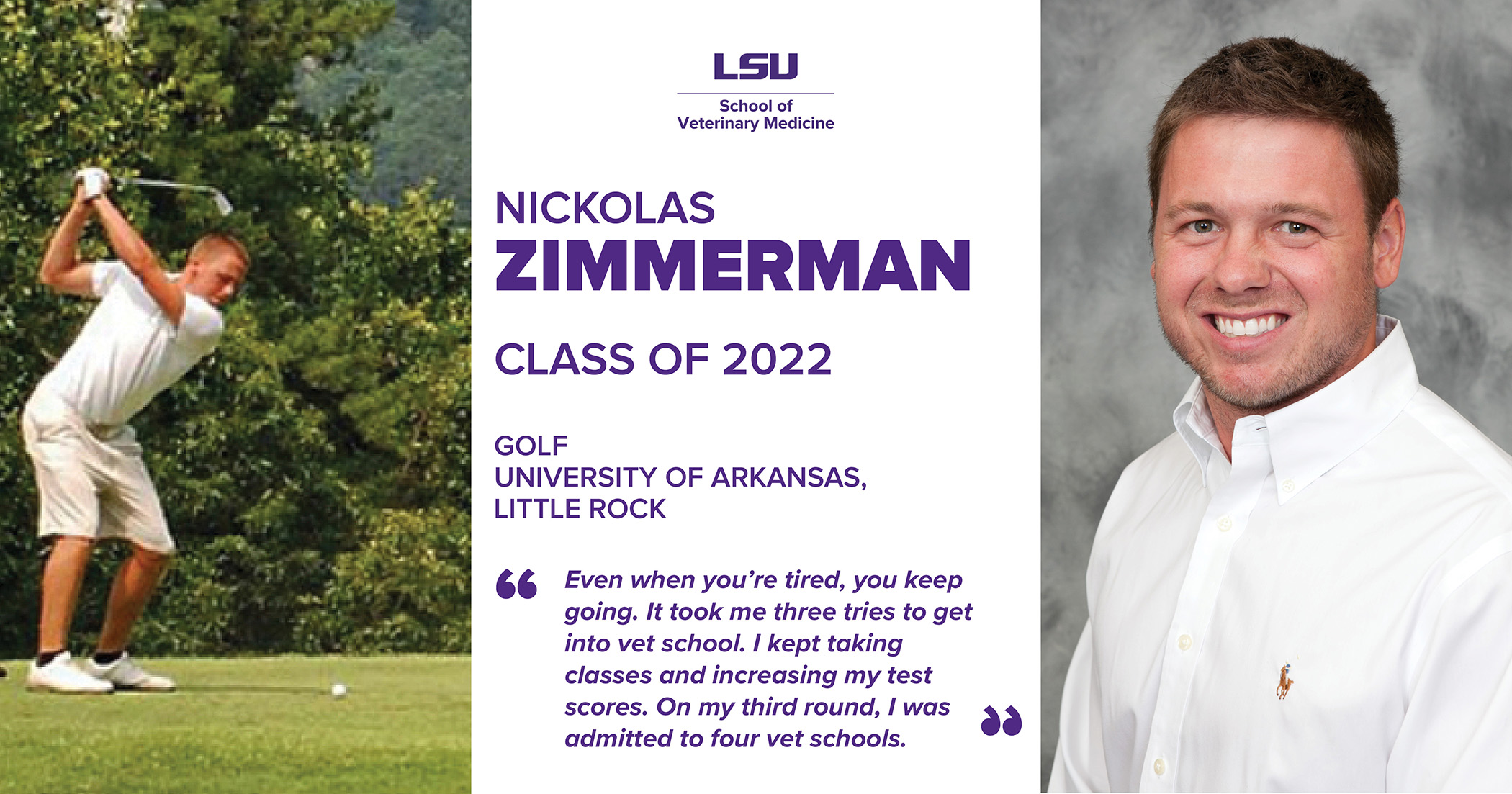
Nickolas Zimmerman, Class of 2022
Golf, University of Arkansas, Little Rock
Team captain
HBU Husky Invitational
Academic All-American (Top 10 in U.S., GPA 3.5 or above, play at least 80 percent of games in tournaments with scores less than 75)
Sun Belt Conference Honor Roll
Father: Ken Zimmerman (LSU Vet Med Class of 1986)
Hometown: Little Rock, Arkansas
“Golf teaches you life skills—integrity, teamwork, dealing with adversity, work ethic, time-management skills, persistence. As a student-athlete, I travelled 12 weeks out of the year for tournaments. I studied on the bus and in hotel rooms when the rest of the team went out to dinner. Even when you’re tired, you keep going. It took me three tries to get into veterinary school—I kept taking classes and increased my GPA and test scores. On my third round, I was admitted to four veterinary schools. Being an athlete helped me stay mentally strong. I want to eventually take over my dad’s small animal practice when he retires.”
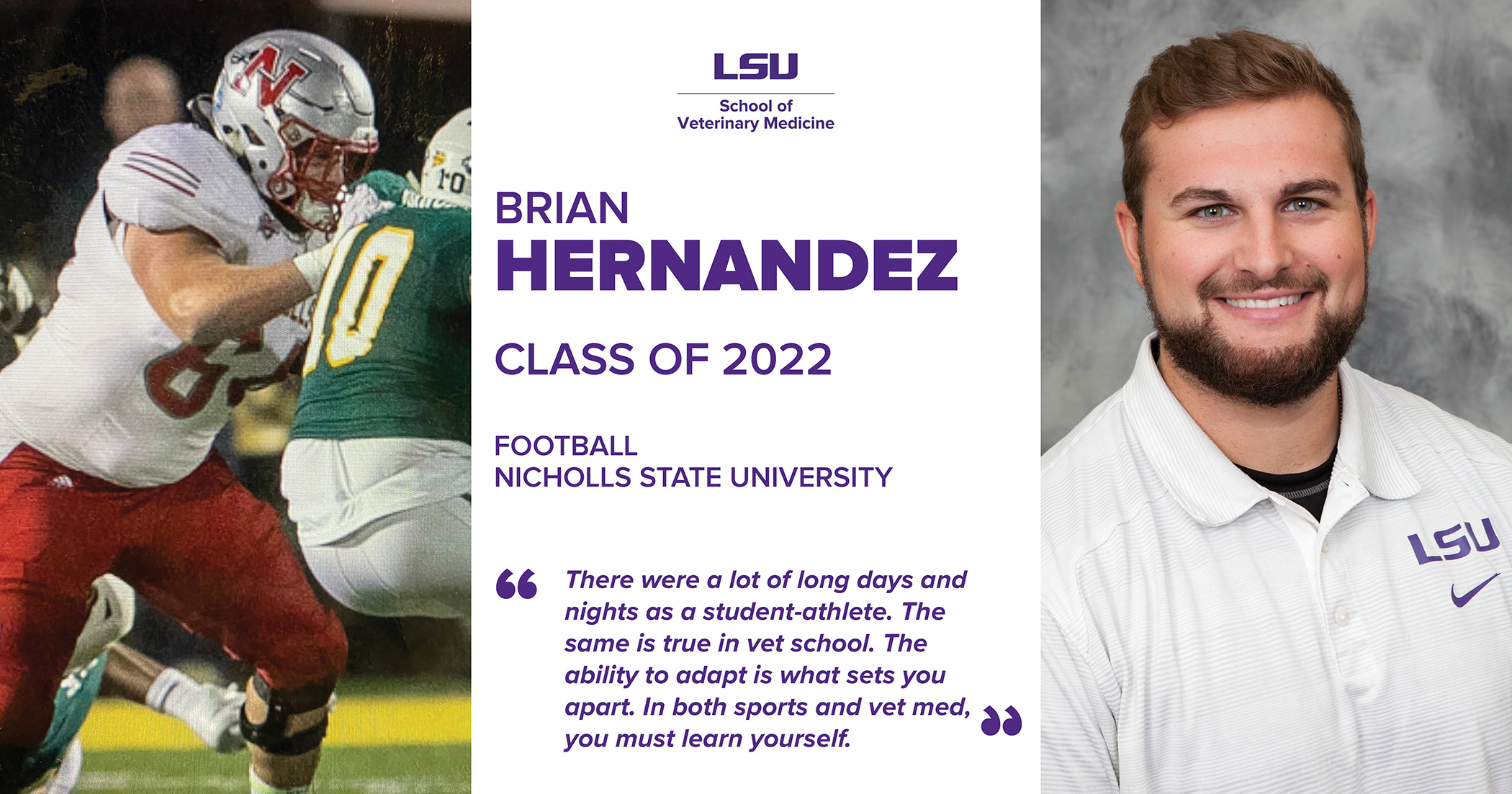
Brian Hernandez, Class of 2022
Football, Nicholls State University, magna cum laude
2017 Southland All-Academic
FCS ADA Academic All-Star Team
Nicholls Football Academic Achievement Award
Mother: Suzie Boucher (LSU Vet Med Class of 1989)
Hometown: Baton Rouge, Louisiana
“Football and academic scholarships paid for my undergraduate education. You can look at football playbook to learn new plays, but until you see how it works on the field, you don’t really get it. Similarly, a vet student can read about how an antibiotic treats an illness, but it doesn’t fully sink in until you see how it works in a clinical setting. There were a lot of long days and nights as a student athlete. The same is true in vet school.
The ability to adapt is what sets you apart. The hands-on active part of medicine is what drives me. In both sports and vet medicine, you must learn yourself. You have to pay attention to your wellbeing—know your boundaries, push yourself to the brink as far as is healthy, and know when to step back for yourself. I grew up in my mom’s vet clinic, which I’d like to take over when she retires. I’m ecstatic I’m on the right path.”
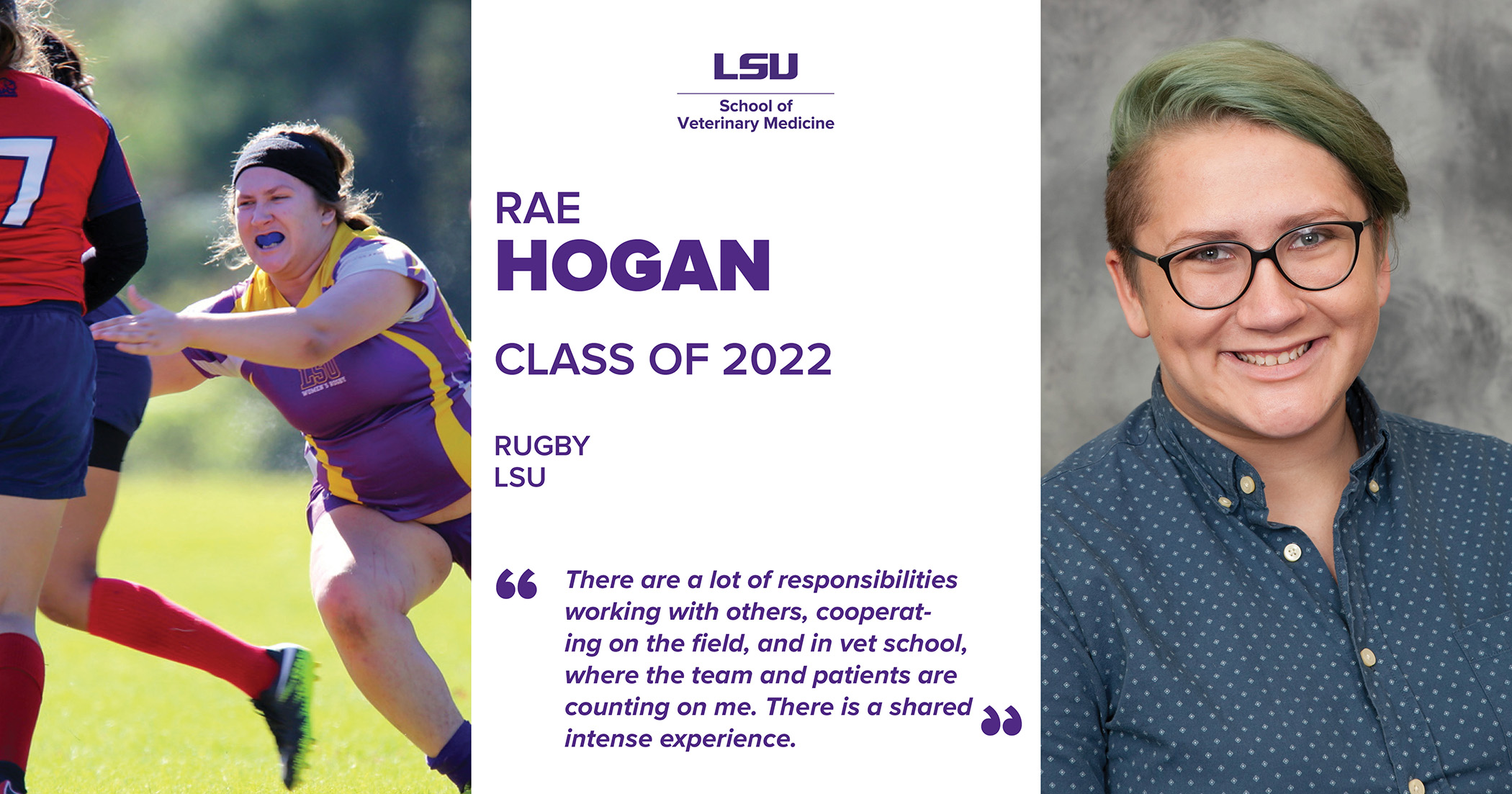
Photo: Steve Guillory
Rae Hogan, Class of 2022
Rugby, Louisiana State University (three years as undergraduate and one year while
at LSU Vet Med)
LSU Vet Med Class of 2020 representative
Hometown: Stonewall, Louisiana
“There are a lot of responsibilities working with others, cooperating on the field and in vet school, where the team and patients are counting on me. Effort and interaction are required for both academic studying and athletic training—you get a payoff for both. In Rugby, when you have a ball flying at your face, you must be able to trust your gut and rely on teammates. The same is true in vet med. Split-second decisions and confidence in them are required in both. I also played goalie in soccer. You’re the last line of defense, and you get good at not blaming yourself when bad things happen. Similarly, in vet med, you can give it your all, but sometimes there’s nothing more to do. Sometimes your best effort doesn’t work out—we are here to learn and keep getting better. Lasting friendships are made in sports and in vet school. There is a shared intense experience. I love the bonds that are formed. You need to consider as an athlete and as a veterinarian how your actions impact others. I have a strong sense of duty and compassion and ask, ‘Is this good for my patient?’ because they can’t speak for themselves. I want to work as a small animal general practitioner with a focus on exotic pets.”
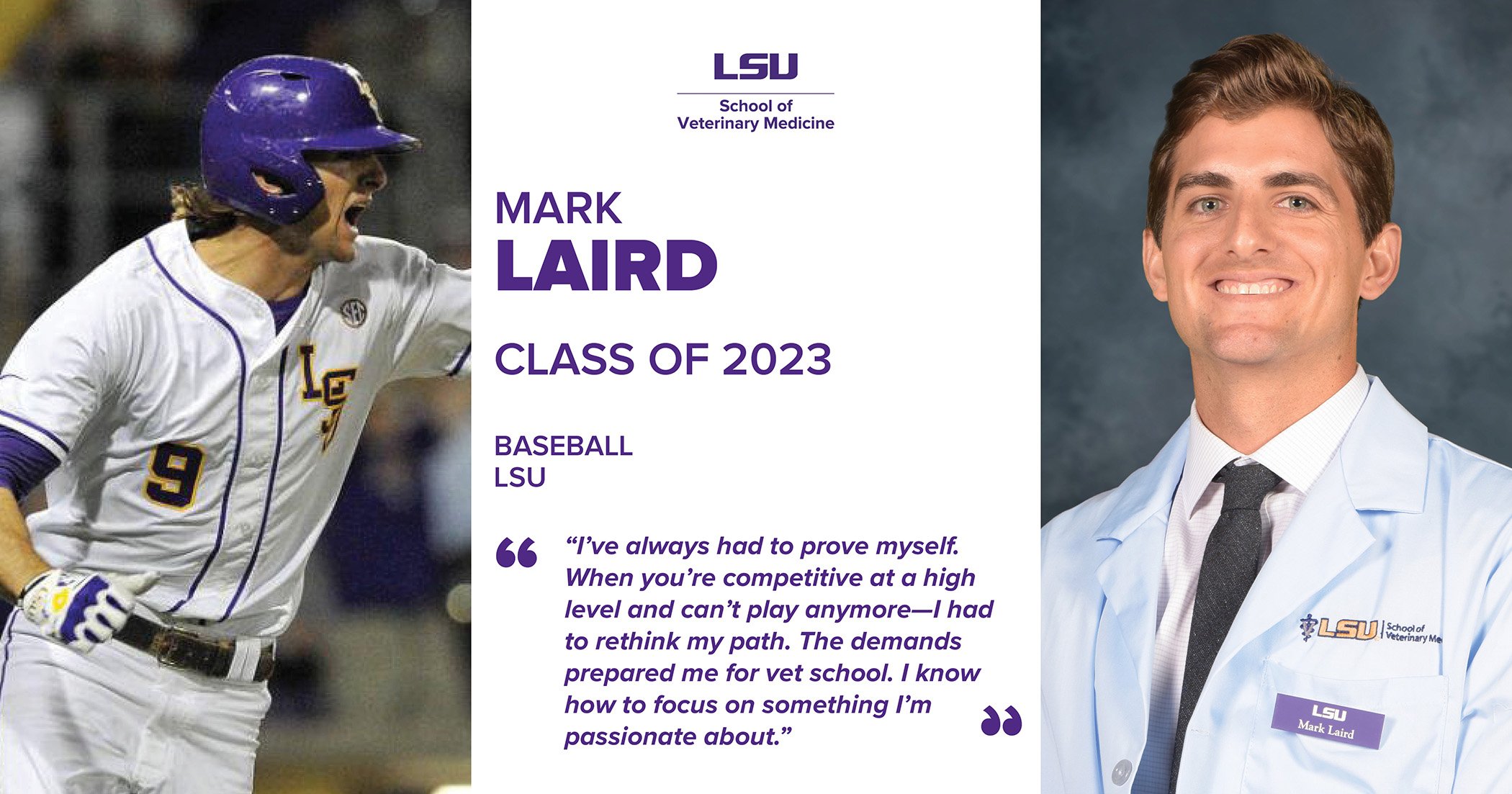
Mark Laird, Class of 2023
Baseball, Louisiana State University
Men’s Baseball College World Series (freshman and senior years)
Louisiana Class 1A Most Valuable Player (2010 and 2012)
SEC Academic Honor Roll
SEC All-Tournament Team
Drafted by Philadelphia Phillies (2015)
Hometown: Monroe, Louisiana
“I have three older brothers; I’ve always had to prove myself. At age 22, I was drafted by the Philadelphia Phillies and for three years I played all over the U.S. As a kid, you dream of this kind of thing. In 2018, I was injured and sidelined. When you’re competitive at a high level and can’t play anymore—I had to rethink my path. The demands of being an athlete—practices, being on the road a week at a time, studying, taking 16 credit hours—prepared me for vet school. Learning to deal with 12,000 people in the audience when you’re on the field helps keep you on an even keel. When I first started at the vet school, I felt there was no way I could memorize what was required—anatomy, physiology, cell biology. My classmates are like my teammates. We help each other out. I know how to focus on something I’m passionate about. Becoming a veterinarian is my sole purpose now. It’s what powers me to be my best. I want to own my own small animal practice in Louisiana.”

Kierra Coleman, Class of 2023
Dance team, Louisiana Tech University
Hometown: Monroe, Louisiana
“Dance has taught me so many positive character traits that I have carried with me into veterinary school. Dancing on a collegiate level taught me endurance, sacrifice and most importantly balance. Performing every weekend and practicing multiple times during the week, all while maintaining a high GPA taught me how to balance school, dance, and life. I learned how to sacrifice some of life’s pleasures, such as hanging out with friends, to focus on more important things like perfecting my dance skills and studying for classes. I’m so blessed to have learned these lessons early in life because many times during this journey of becoming a veterinarian I wanted to quit and give up, but I remembered that there will be seasons in life where I must toughen up and endure a little pain and discomfort in order to achieve my goals. Now I am excelling in vet school and accomplishing everything I set out to do and more! I am co-charter and president of a new organization known as Student Association for Black Veterinarians. I am a first-generation college graduate, and I will be the first doctor in my family. I plan to practice small and exotic animal medicine and while possibly coaching a dance team in my spare time.”

Babette Sanmartin, Class of 2023
Basketball, St. Vincent College
2017-18 All-PAC Honorable Mention honors
Hometown: Gaithersburg, Maryland
“Being an athlete was a lesson in time management. Basketball is a winter sport, with pre-season in the fall and post-season in the spring. We did 7 a.m. conditioning Games run two-to-three hours a week. On every bus ride I would be doing schoolwork. I had to make sacrifices and give up most of my social life. I don’t regret it. We had great relationships with teammates. We came out stronger, better, we all did it together. In vet school I have a friend I study with for tough exams. I’m very excited about being a veterinarian. I want to go into laboratory animal medicine. I was a summer fellow with the Department of Laboratory Animal Medicine. I want to be part of the bigger picture of helping advance medicine for humans and animals.”

Coleman Wahlborg, Class of 2022
Tennis, University of Louisiana at Lafayette
2017 Second-Team All-Sun Belt Conference (Doubles)
2015 First-Team All-Sun Belt Conference (Doubles)
2015 Second-Team All-Louisiana (Doubles)
Hometown: Baton Rouge, Louisiana
“I had a tennis scholarship, half-tuition, for all four years. I’m a very competitive person on the tennis court and in the classroom. I’m competitive with myself. I set lofty goals in the beginning. It’s a game to me figuring out how good I can get at something. Each year, I’d make a goal for myself—best player on the team so I’d at least start. With tennis, sometimes you do all you can and never achieve greatness because there are physical variables you cannot control. I decided I wanted to be a veterinarian my third year at ULL. Going into the School of Veterinary Medicine, I wanted to be in the top five in my class. If I achieved anything close to that high, I’d be doing great. Then, if I finish in the top 10, I’m satisfied. My goals are most important. I’m 110 percent devoted.”
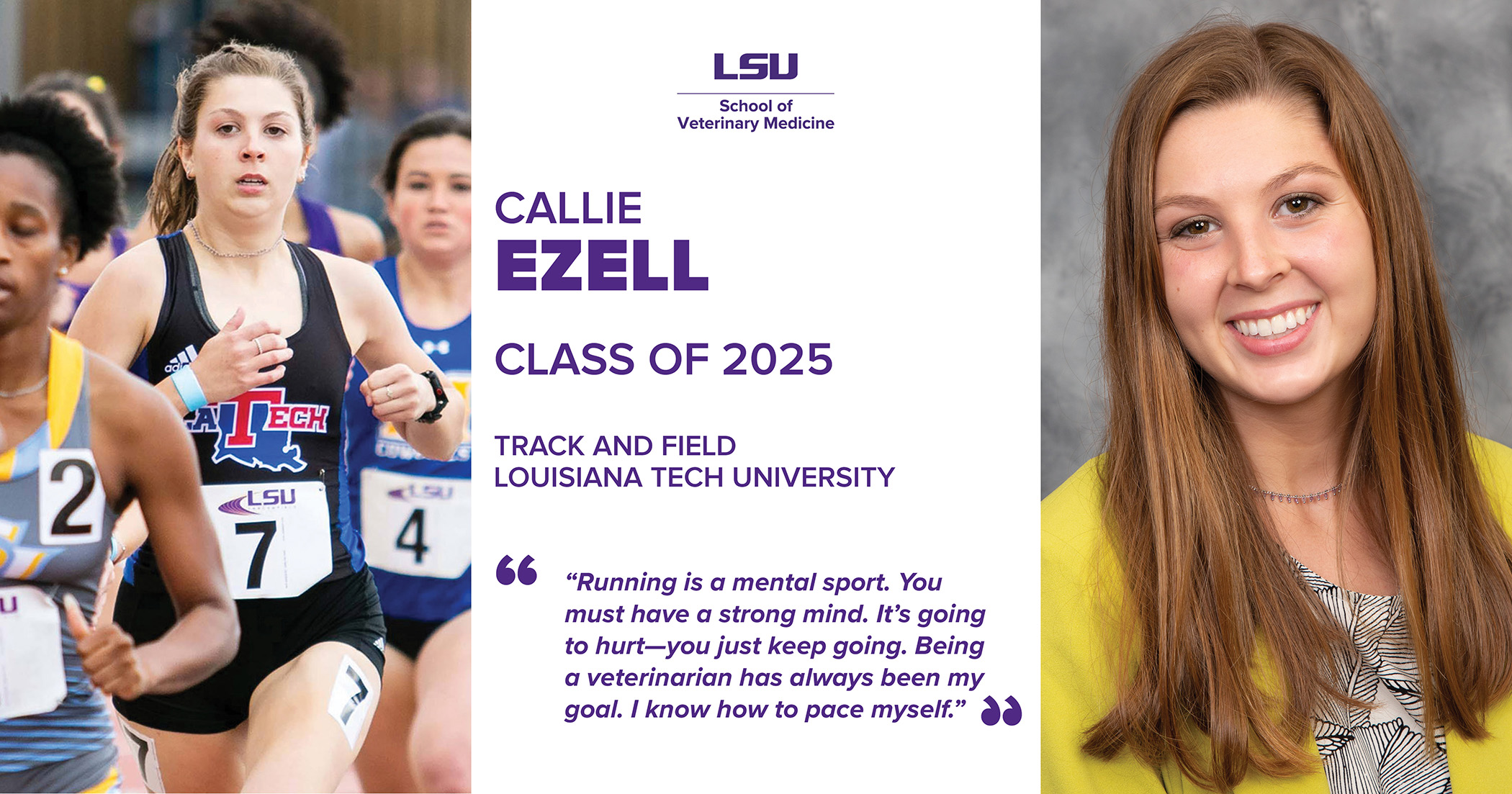
Callie Ezell, Class of 2025
Cross country, track & field, Louisiana Tech University
C-USA Track and Field All-Academic Team
C-USA Academic Medalist
C-USA Commissioner's Honor Roll
Valedictorian, St. Frederick High School
Hometown: Delhi, Louisiana
“Running is a mental sport. You must have a strong mind. It’s going to hurt—you just keep going. Our coaches were adamant about nothing getting in the way of school. Our teams would travel Friday night and return Saturday after the meet. We had Sundays off. I strived to be the best I could be. If I’m going to do something, I’m going to do it well. I worked on Louisiana Tech’s livestock farm for two years tending pigs, sheep, donkeys, and chickens. I shadowed the veterinarian in the clinic. I became a manager there hiring employees and selecting sows and boars for breeding. Being a veterinarian has always been my goal. Learning muscles and bones, how they relate to each other, how they move, is fascinating, particularly as an athlete. I still run for stress relief, but now I’m just doing school—no more 6 a.m. practices. I know how to pace myself.”
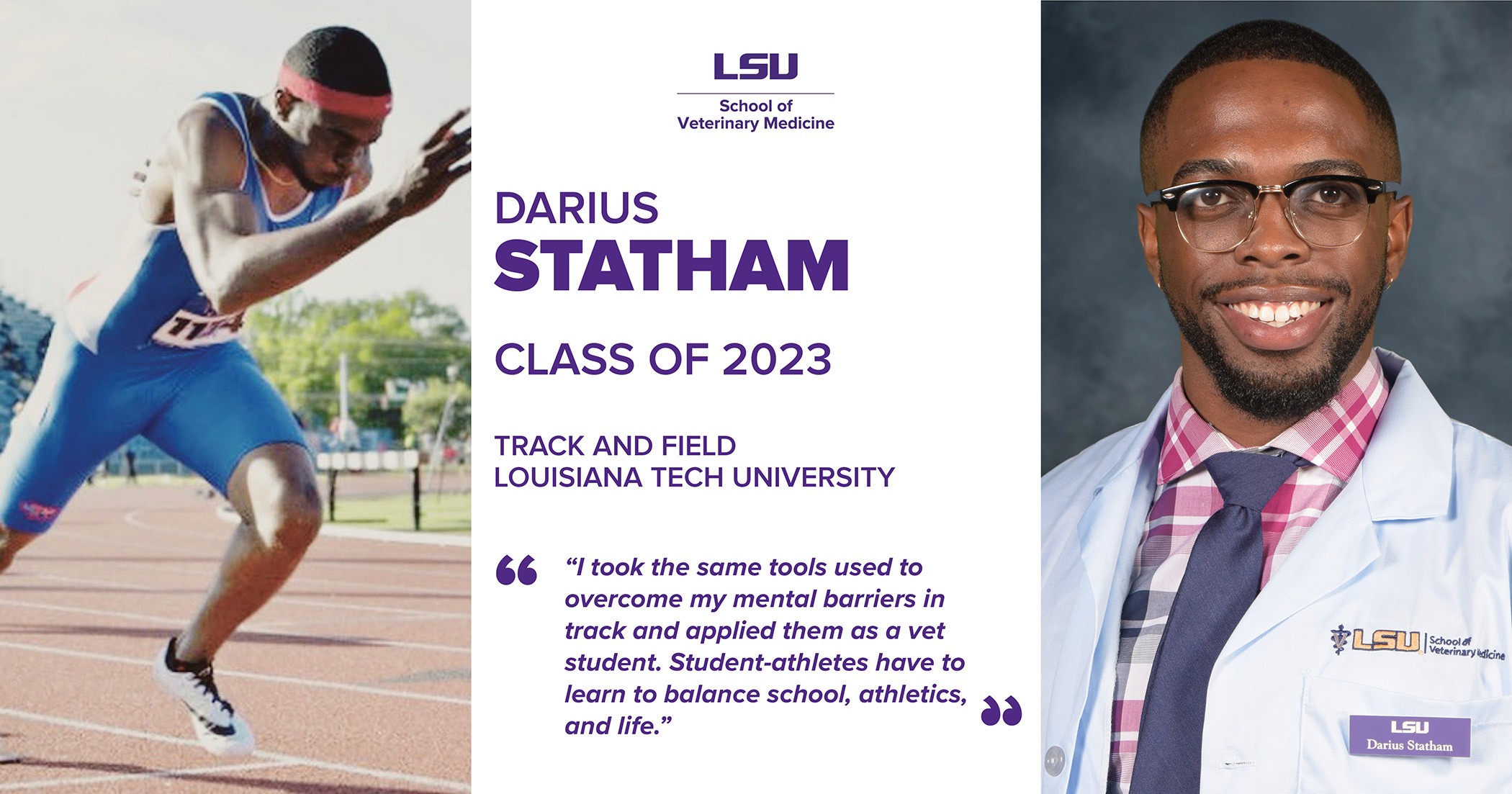
Darius Statham, Class of 2023
Track & field, Louisiana Tech University
2014 Indoor First Team All-Conference USA (4x400m Relay)
2015 Outdoor Second Team All-Conference USA (4x100m Relay)
2013 Georgia 400-meter state champion, Most Outstanding runner, Most Valuable Player (Mays High School)
Founder, LSU Student Association for Black Veterinarians
Hometown: Atlanta, Georgia
"My time as a student-athlete has had everything to do with my resilience in veterinary school. My track coaches drilled into us how important it was to focus on our own race. I heard them but it didn't stick at first. I would look around wondering why I wasn't performing at the same level as my competition or if I even deserved to be in the same line up. My real problem was I wasn't concentrating on my own lane. My coaches helped me realize that I was the one holding myself back. So, I started to overcome mental blocks, cut out negative thoughts, and went even harder. I had the exact same self-doubts starting vet school. I took the same tools used to overcome my mental barriers in track and applied them as a student. Now I have my advisors (Dr. Henry Green and Dr. Lorrie Gaschen) to remind me not to defeat myself before my race even begins. Student-athletes have to learn to balance school, athletics, and life. As a full-time student in a rigorous program while chartering and leading a new organization, Student Association for Black Veterinarians, I wouldn’t be this efficient with my time management in veterinary school without that experience as a former student-athlete."
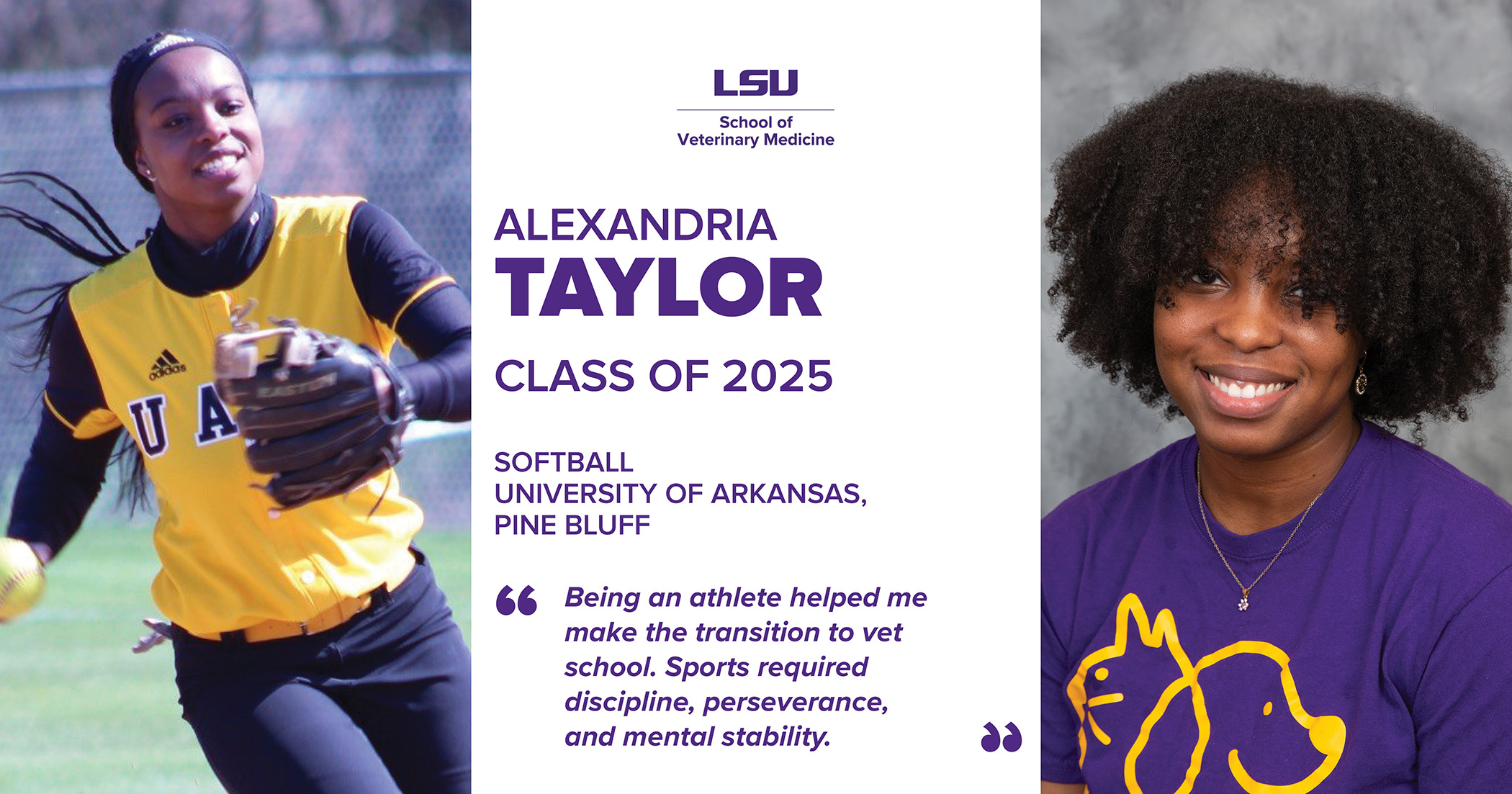
Alexandria Taylor, Class of 2025
Softball, University of Arkansas, Pine Bluff
2019 Team Captain
Voted Hardest Working teammates
Hometown: Dallas, Texas
“I’ve been playing softball since age 4. I was planning to try out for the 2020 Summer Olympics. Softball was added back that year but postponed to 2021 due to the pandemic. My softball scholarships covered my undergraduate education. Being an athlete helped me make the transition to vet school. Sports required discipline, perseverance, and mental stability. I can understand why some quit. I worked as a vet tech in a Dallas small animal clinic for two years. I want to specialize in Dermatology because it involves the power of observation. My biggest academic achievement so far was getting into vet school. It was expensive and hard work. I spent a year-and-a-half retaking classes. I was voted Hardest Working by my softball teammates because I showed up to every practice, pushed myself 100 percent, and participated in every fundraiser. At vet school, I show up every day, ask questions, and join clubs. Anatomy class shows us things like how important the patella is for flexing and extending muscles, something our coaches also told us. I miss playing softball, but it’s nice not to have sore arms or legs when I show up to class.”

Mark Golay, Class of 2024
Cross country, track & field, University of New Orleans
2016-18 Southland Conference Championships
2017 NCAA South Central Regional
2015 South Central Region Cross Country Championships
2015 Southland Conference Championships
Valedictorian, Ridgewood Prep High School
Hometown: Metairie, Louisiana
“We travelled every weekend for meets. I missed a lot of Friday classes. I had to take tests early, immediately after the lecture. Being a student-athlete played a big role in getting into vet school. It proved I could manage demands. As a runner, I had to be in bed by 10 p.m. to be up to run by 5 a.m. My meet and practice schedules could be unpredictable due to weather and other uncontrollable factors. I had to roll with it. I like that my vet school schedule is predictable. It allows me to look ahead and accomplish what I need to get done. The drive I had as an athlete (personal record in the mile is 4:29) is still with me as a vet student. I still go for my personal best. Running instilled confidence. I know who I am and what I’ve done, which serves me well in vet school. I still run for relaxation. When fall comes, I can feel in my body it’s cross-country season and time to race. I worked at the Audubon Aquarium of the Americas in New Orleans feeding sharks and fish common to the Gulf of Mexico. I want to work in aquatics after I graduate.”
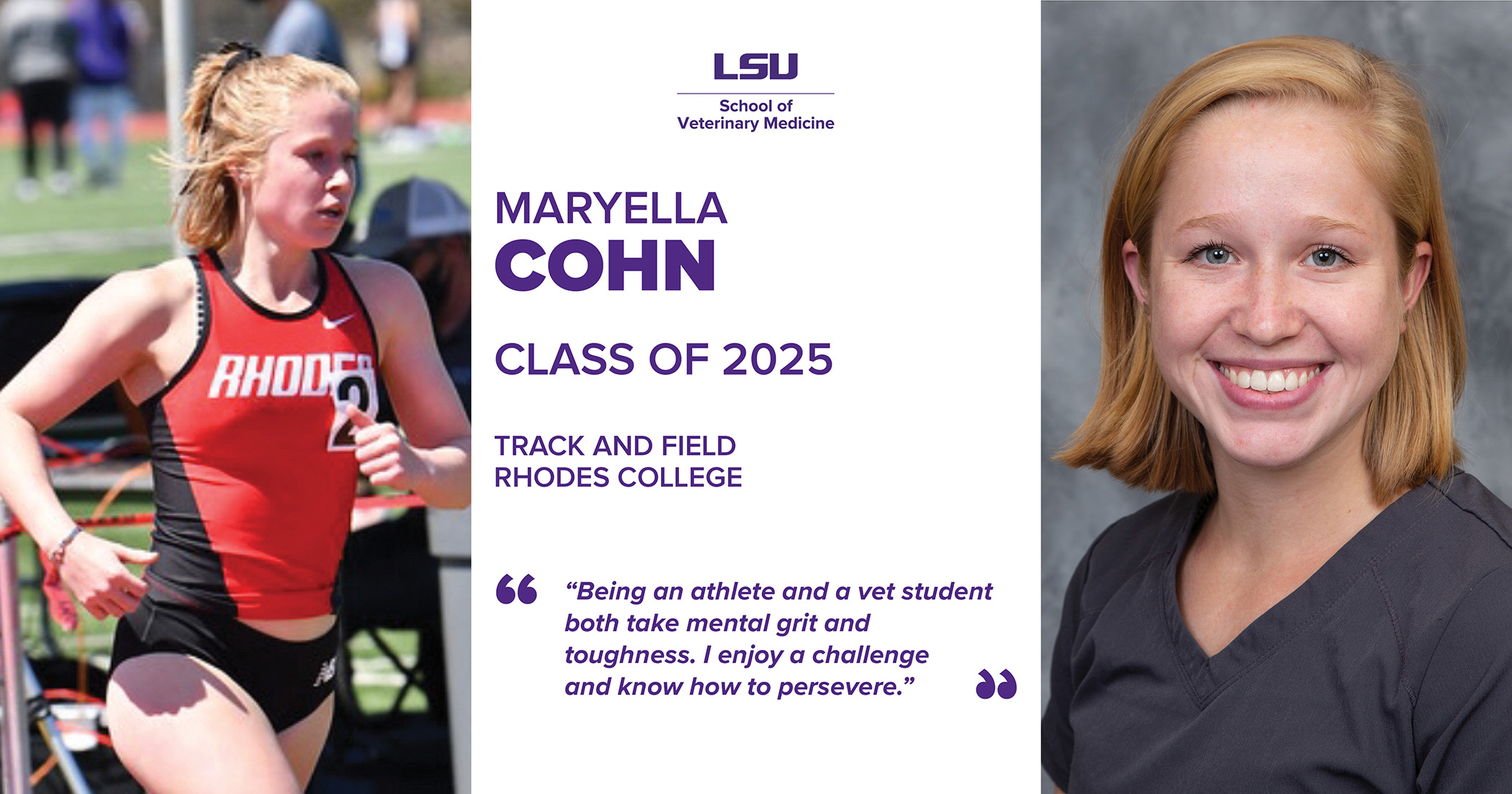
Maryella Cohn, Class of 2025
Cross country, track & field, Rhodes College
2016 track regionals first place
All-State cross country
Academic All-State cross country
2016 State third place cross country
District Champion cross country
Hometown: Houston, Texas
“I have wanted to go to the LSU School of Veterinary Medicine since I was a little girl. I come from three generations of Tigers. I’m prepared for vet school because of the discipline required as an athlete. Both take mental grit and toughness to get through. I enjoy a challenge and know how to persevere. I value the teamwork among vet students. We’re all trying to get to the same place, and we can get a lot further together. As an athlete, I was MVP, running nationally qualifying times, always chasing a PR (personal record). Then, at my peak, I got injured and underwent surgery and rehabilitation. As I worked to regain my fitness, I led my team and helped them win. I consider this my greatest success as an athlete. As for my career, I am interested in wildlife and conservation. I spent a month in Namibia, South Africa, doing conservation efforts with lions, rhinos, and elephants. We studied the numbers and types of animals at water sources now that climate change has compromised those sources. We camped in tents in the desert. Being a student-athlete taught me that I could push past my limitations to accomplish my goals no matter what I am doing.”
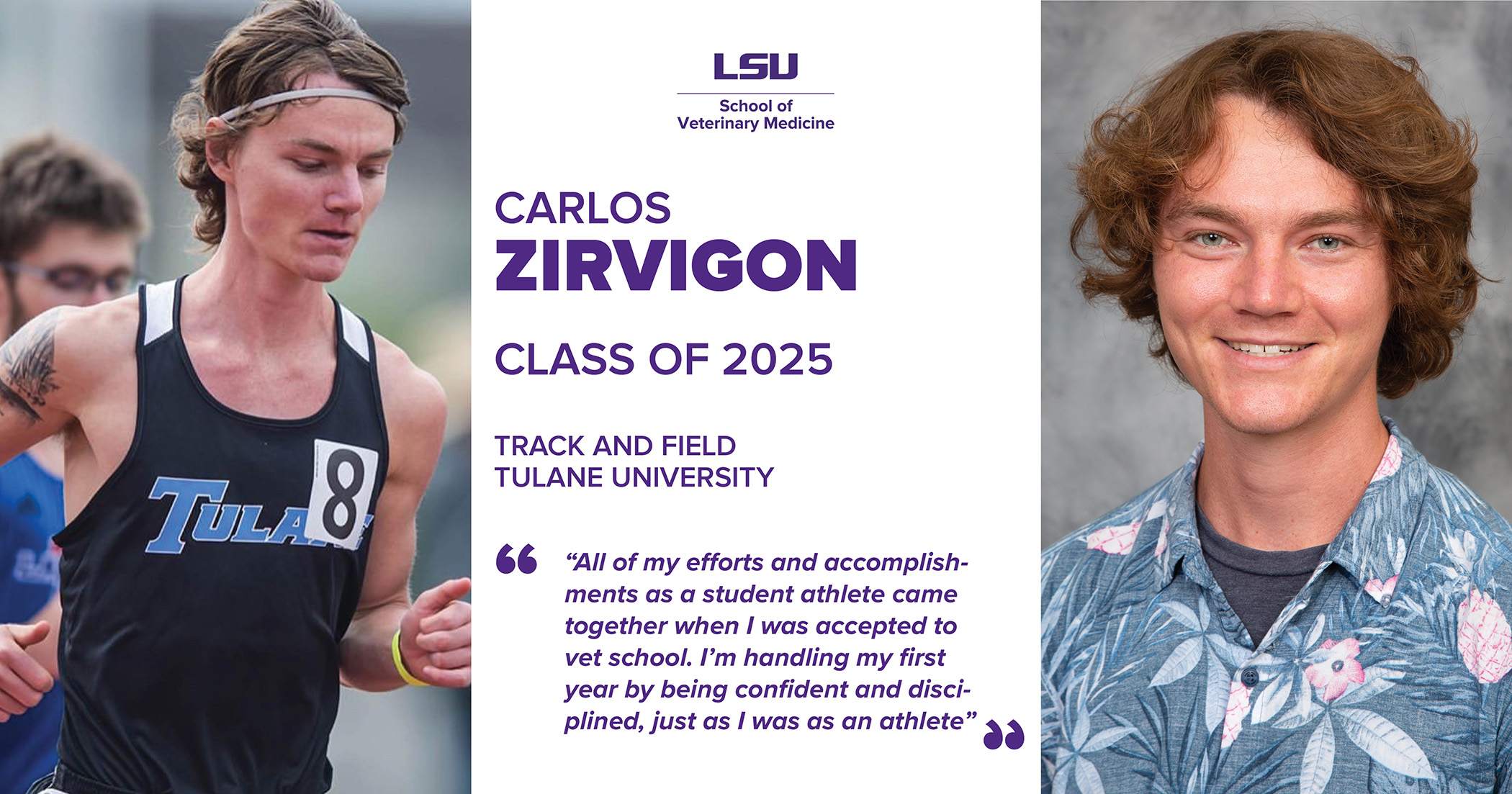
Carlos Zervigon, Class of 2025
Cross country, track & field, Tulane University
2019-20 Cross country:
Finished 59th at the NCAA South Central Regional Championship
American Athletic Conference Championship
American Athletic Conference All-Academic team (2017-2020)
2018-19 Track & field:
Finished 10th at The American Outdoor Championship 10k
Placed 5th at the Southern Miss Open
Placed 3rd Southeastern Louisiana Strawberry Relays
Hometown: New Orleans, Louisiana
“Cross country and track are year-round sports. What I did as a student-athlete is helping me to not fall behind in vet school. A lot of information is thrown at us the first year. I apply the same level of commitment to my veterinary studies as I did as a student athlete. During my senior cross country season, I had a stress reaction in my foot and missed six weeks of training. I could have either let the injury get the best of me or continue being disciplined with my training. I chose the latter and worked out in the pool and on the elliptical. I worked through the injury and came back stronger. In high school, I had chronic exertional compartment syndrome, which rendered my calf muscles useless. I spent a total of six months recovering from multiple surgeries. Once I got healthy, I helped lead the team to back-to-back state championship victories my junior and senior years. All of my efforts and accomplishments as a student athlete came together when I was accepted to vet school. I am the first recipient of the A.B. Freeman Scholarship, which pays my tuition all four years. Outside of the classroom, I have been hired as a live-in at the Veterinary Teaching Hospital. We have a supportive group of live-ins here. I wanted to have a team feeling since I’m no longer on a sports team. I’m handling my first year of vet school by moving from one step to another, being confident and disciplined, just as I was as an athlete.”
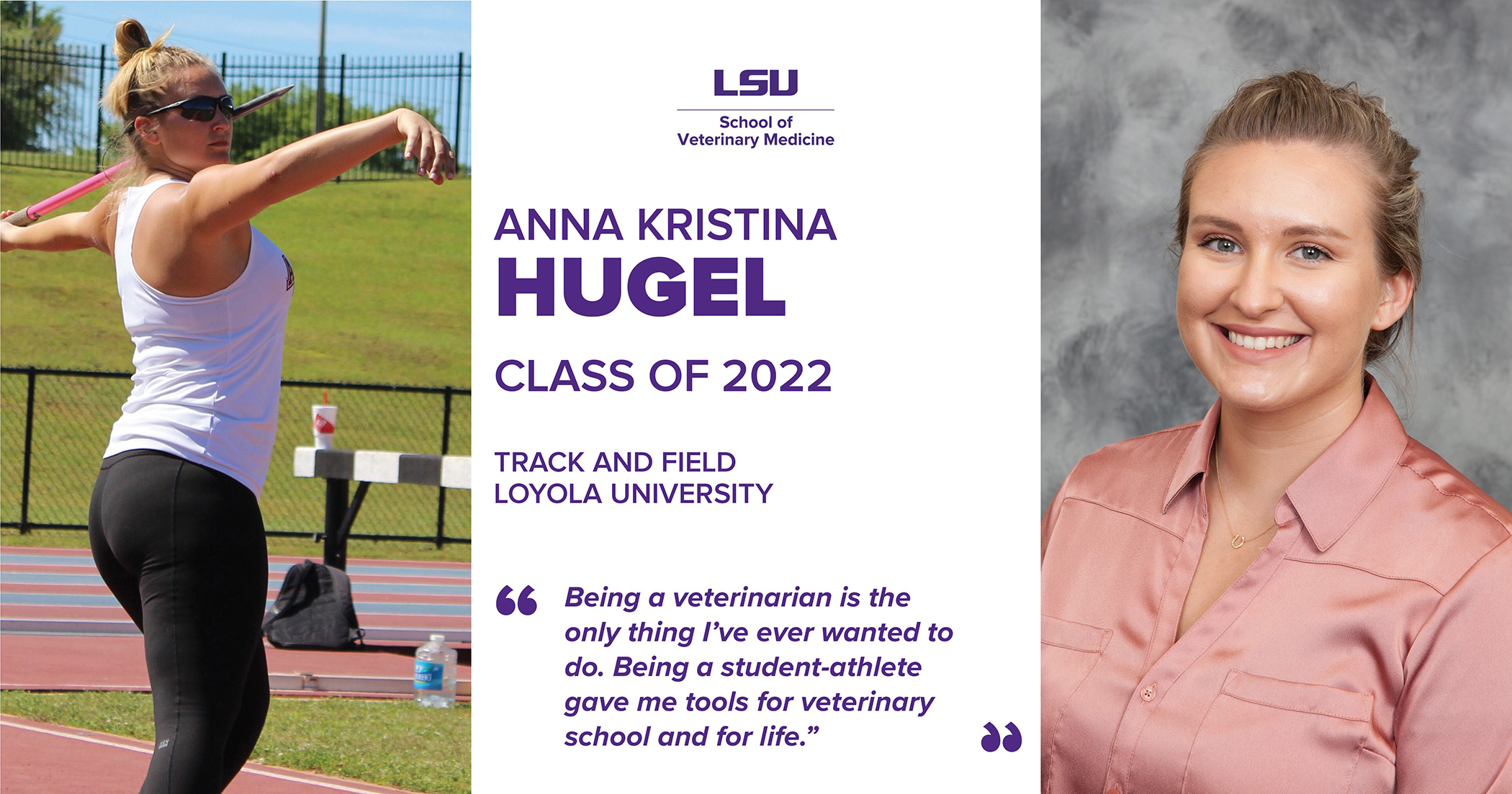
Anna Kristina Hugel, Class of 2022
Javelin, discus, hammer, Loyola University, New Orleans
Field Team Captain
Southern State AC Outdoor Conference Track & Field Championships
Tulane Early Bird Twilight Track and Field Invitational
Louisiana Classic
Southern Miss Invitational
University of Mobile Invitational
Hometown: New Orleans, Louisiana
“My pediatrician asked what I wanted to be when I grew up and I said, “A veterinarian.” It’s the only thing I’ve ever wanted to do. I try to keep as healthy as possible. Life can throw you all kinds of curve balls. As a high school senior, I tore my rotator cuff and had surgery to reconstruct my shoulder before going to college. I was field team captain in charge of making sure all equipment was in place.
There was no room for last minute actions. I had surgery on both knees my sophomore year of college. I have a great appreciation for physical therapy and its power to rehabilitate. I love the Integrative Medicine program at the vet school. It was wonderful to see what it could do for my old dog. I obtained my acupuncture certification about a year ago. As an athlete, I worked out twice a day, every day. Working out gave me a stress reliever and helped my physical and mental wellbeing. Being a student-athlete gave me tools for veterinary school and for life.”
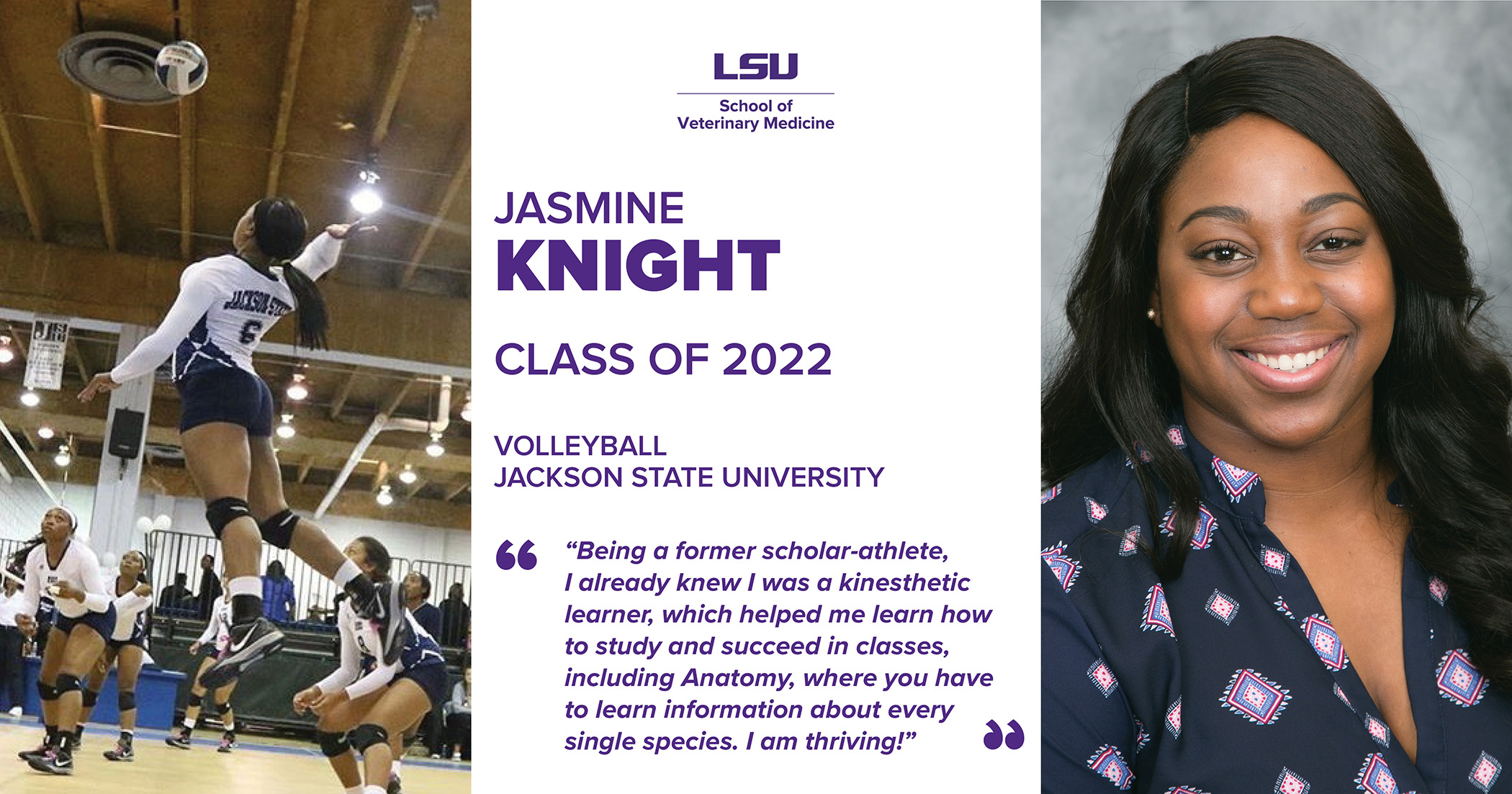
Jasmine Knight, Class of 2022
Volleyball, Jackson State University
2012 and 2015 Volleyball SWAC Champion
Volleyball Team Captain
Hometown: Belle Rose, Louisiana
It was instilled in me at a young age to always work hard. I’m a first-generation college graduate. I was captain of my volleyball team during my senior year of undergraduate school at Jackson State University. There were 16 women on the team, all with different personalities and backgrounds. We had games Tuesdays, Fridays, and Saturdays and would leave on Thursdays for weekend games. I learned early on to build strong relationships with my professors. If I had a tournament, I would let them know in advance and turn in my work early. That experience helped me to balance the demands of veterinary school. The course load was extremely difficult in the beginning. Being a former scholar-athlete, I already knew I was a kinesthetic learner. Eventually, I discovered that I am a visual/auditory/hands-on learner after taking a test at the LSU Center for Academic Success. Knowing this helped me learn how to study and succeed in classes, including Anatomy, where you have to learn information about every single species. It is the main building block to the remainder of your coursework. Since starting clinics, I have been able to apply classroom knowledge and communication techniques, and I am thriving!
Communication is key in school as it was in athletics. After graduation, I plan to work as a small animal general practitioner and to pursue specializing as a Dermatologist.

Quinci Middlebrooks, Class of 2022
Cross country, Track & field, Louisiana Tech University
Record holder, Distance Medley Relay, Louisiana Tech University
Junior Olympics USA Track & Field (California, North Carolina, Oregon)
Hometown: Benton, Louisiana
“When asked if my interview to get into veterinary school was difficult, I answered, “Not as hard as running an 800-meter race.” You’re alone on the track, and all eyes are on you. It’s intimidating, and it builds confidence. My team always got the award for the highest GPA. I came out of the womb wanting to be a veterinarian. My family has horses. My mom and I barrel race together. In high school, I had a business breeding miniature pigs. While a student-athlete all through undergraduate school I worked on a farm. I got up at 5 a.m. to feed the 200-lb. hogs, plus pigs, chickens, and sheep. After that, at 6:30 a.m., I went to cross country or track practice. I enjoy being surrounded by driven people—as an athlete and as a vet student. I don’t want school to end. I’m learning so much. But I’m ready for my first paycheck."
Writer
Sandra Sarr, MFA
A Net of Grace
Dog Survived Throw from Balcony, Treated at LSU Vet Med ER; Adopted and Thriving in Connecticut
Published January 5, 2021

It was Halloween 2018. The quarreling couple became so loud that a neighbor stepped outside to see what the racket was all about. Just as she did so, she witnessed the girlfriend throw her boyfriend’s puppy off of a second-story balcony in a Baton Rouge apartment complex. The neighbor-turned-Good-Samaritan rushed the six-month-old yellow Labrador retriever to the LSU School of Veterinary Medicine for help.
Anne Katherine Landry, now a second-year veterinary student, was on duty as a veterinary technician in the Intensive Care Unit when he was brought in.
“We put him on the table and Virginie Wurlod, Dr.med.vet., MSc, DACVECC, DECVECC, assistant professor of emergency and critical care, stabilized him and checked to see that he was alert and responsive. His leg was badly broken. She put him on a pain management plan,” said Anne Katherine of Delcambre, La.
Radiographs revealed a left distal femoral fracture. Levon’s team administered hourly treatments, gave medications, took temperature, pulse, respiration rate, changed his wound dressing, and walked him outside.
“We wondered how anyone could do what they did to him. He’d be wagging his tail and was so kind and forgiving toward people. He was still wanting to interact with us,” Anne Katherine said.
Levon remained in the hospital for two days. LSU Vet Med’s Good Samaritan Fund, established for the medical care of homeless animals in need, covered his expenses. Annually, LSU Vet Med spends $65,578 on average on Good Samaritan cases.
“We see about five to 10 Good Samaritan cases a week,” Dr. Wurlod said.
The 350 or more animals in need of emergency treatment brought each year by Good Samaritans to LSU Vet Med 24-hour emergency facility receive emergency services, critical care, testing, and ICU care. Ownerless animals often stay at the school for days or even weeks as they heal.
Good Sam patients are scanned for microchips and posted to the Lost and Found Pets of Baton Rouge Facebook page in an effort to locate their owners.
“We’re able to take animals like Levon from cruel and heartbreaking situations, treat them, and make their lives better. Imagine the life he would have lived, and look at him now,” Anne Katherine said.
When he was stable enough to be discharged from ICU, Companion Animal Alliance took him into their care in early November 2018. CAA posted on their social media page for fosters that they needed a foster home commitment before they scheduled surgery. Laurie Lynn Drummond had fostered other dogs with medical needs for CAA and expressed interest in Levon. Anne Katherine, who’d been a student in Laurie’s Animal Welfare service learning class, saw her comment and messaged Laurie about her experience of the dog at LSU Vet Med. Laurie picked up Levon the day after he arrived at CAA. Laurie fostered him for four days before his amputation surgery could be scheduled. She picked him up the afternoon of his surgery and did his post-surgery care. She re-named him Anders and gave him a temporary home while he fully healed and was ready for adoption.
Laurie’s acquaintance mentioned a couple in Connecticut looking to adopt a dog.
Tasha Mechne and Kim Gunter of Stratford, Conn., adopted the dog at eight months old and named him Levon after Levon Helm of The Band. Tasha is operations office assistant in Fairfield University’s Provost’s Office, and Kim is director of Fairfield’s First-Year Writing Program. After the Fairfield colleague of Kim’s connected the couple to Laurie, a writing instructor in the LSU English Department, they emailed regularly about Levon as he healed.
“It was one of those ‘you need to meet each other’ because our mutual friend knew we were planning to get a rescue dog,” Tasha said.
“Laurie is so devoted to making sure her fosters get really good homes. We messaged back and forth about Levon. Finally, CAA approved our adoption. I’m very grateful for that organization and to all those who helped Levon,” Tasha said.
“There was something about his face. You could see his soul. Looking at his pictures, you could sense a kind, dear boy, so loving, and that’s him. That’s exactly what we got,” Tasha said.
Levon made the two-and-a-half-day road trip from Louisiana to Connecticut in a Rescue Road Trips 18-wheeler. Rescue Road Trips is a nonprofit that provides low-cost transports for rescue dogs in the South to points North. Kim and Tasha received videos of Levon at the various stops. Waiting with anticipation in a crowd of adopters as the truck arrived, Kim and Tasha heard their dog’s name called and he was led to them. He was finally home.
“We never thought we could love another dog as much as we loved our rescued pug, ‘Sadie,’ but our love for Levon even exceeds what we’ve known. I’m evolving as an animal lover. Animals speak to us on a deeper level than language. They break down our shell. We have these animals that help us leapfrog over obstacles to growth.,” Tasha said.
Now, Tasha, Kim, and Levon go to the woods for walks and the river for swims. At first, Levon was tentative. He had no experience being near water. He quickly realized he could fetch and discovered he enjoyed swimming.
“Seeing that is the biggest joy in my life,” Tasha said, even as she is reminded every day about Levon’s sad past.
“It’s pretty heartbreaking. Something in the way he moves or behaves reminds me. But it’s easy to forget he has only three legs because he’s so fast and agile. If he had four legs he’d get everything off the counter he could. He loves dish towels,” Tasha said.
She used to get angry about the people who abused him. Now she focuses on the fact that he’s living his best life.
“I feel so grateful he’s here with us,” she said.
Writer
Sandra Sarr, MFA
Communications Manager
2020
I Really Felt Like They Loved Our Dogs: Grateful Client Becky Kirk
Published December 1, 2020
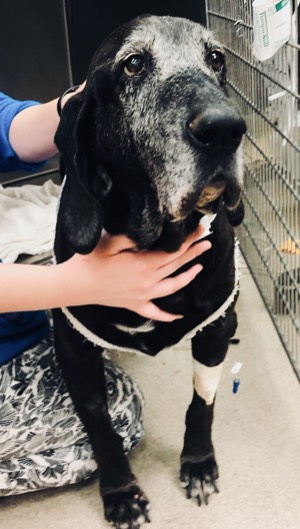
“At LSU SVM, you get scientific knowledge, excellent medical care, and compassion. That’s not available everywhere.”
When Becky Kirk’s dogs, Jackson and Loosey, became seriously ill, her Acadiana-area veterinarians referred her to LSU School of Veterinary Medicine to help dogs that were members of her family from puppy to old age. Kirk made the 155-mile roundtrip trek from Abbeville to Baton Rouge multiple times, first with Jackson and several years later with Loosey, for diagnosis and treatment.
The healing journeys started in late 2011 when Jackson, a large brindle boxer/shepherd/pit bull, began limping. Jackson eventually was diagnosed with bone cancer. At LSU Veterinary Teaching Hospital his back leg was amputated up to his hip. Kirk remembers Jackson’s surgeon consoling her, saying, “Dogs only need three legs; God gives them a spare.”
While Jackson was in the hospital, medical team members sent Kirk pictures of him and called her every day with updates. “You wait for those calls,” she said. A student once told her, “Jackson seemed scared, so I laid down and slept next to his crate.” It’s that level of compassion and round-the-clock expert care that led Kirk to become a repeat client and refer friends.
The Cancer Treatment Unit at LSU Veterinary Teaching Hospital was formed in 1998 to aid in the diagnosis, care, and treatment of veterinary patients with cancer. With its mission of turning cancer patients into cancer survivors, it has two major service units—medical oncology (chemotherapy) and radiation oncology. Each is designed to diagnose and treat veterinary cancer patients with the most advanced technology available.
After Jackson’s second round of chemo, Dr. Melanie Mutz, with tears in her eyes, knelt next to Jackson, gave him a big hug, and told him he was a good dog. She advised Kirk that there was no further medical treatment that could help him have a good quality of life.
Now, eight years later, Jackson is remembered fondly by Oncology Service faculty and staff.
Kirk said life circumstances at the time Jackson fell ill presented a challenge in covering vet expenses.
“Jackson made me realize how people must feel when they can’t afford care. I was so grateful that they worked with us,” Kirk said.
In October 2018, Kirk would return to LSU SVM, this time with her dog, Loosey, who was diagnosed with oral melanoma. They discussed a treatment plan and associated costs. Kirk opted to go forward with the treatment plan.
The oncology service works from a team approach, so a patient requiring chemotherapy or radiation therapy has the benefit of being evaluated by specialists who design a treatment protocol tailored to their individual needs.
“Everyone was so kind. They answered all of my questions. You don’t want someone talking to you like they’re reading from a menu. You want someone who really understands that this is my family member we’re talking about,” she said.
Loosey’s golf ball-sized tumor responded immediately to radiation and she was able to resume her usual life at home.
Then, in Spring 2019, the half bloodhound-half Labrador retriever collapsed while on a walk near Kirk’s home. Loosey struggled to breathe and she returned to the SVM. Loosey remained in ICU for 11 days at LSU SVM to get her stabilized and access her condition. That’s when they found liver and adrenal cancer.
“The radiation treatment was amazingly effective. If the oral melanoma had been her only problem, she would have been with us a lot longer,” Kirk said.
Kirk first saw Loosey as a homeless puppy at a vet’s office. “I just wanted her. She was the kindest, sweetest dog ever. She would comfort us by putting her head on our shoulders and come check on us when we were yelling about football on TV,” said Kirk, a devoted LSU football fan.
According to Shay Bordelon in radiation oncology, Loosey was a good sport and cooperated with all treatments, which usually lasted one hour and required general anesthesia to keep her still. Loosey was always happy to see the medical team. If Loosey needed additional specialty services, for example, a CT scan, she could get it the same day at the veterinary school.
“My experience was very positive. I felt really confident in the care we were getting. They give you information and you decide on the best course of action. I never questioned their competency. They know how important your pet is to you,” she said.
“Becky and Loosey fought hard,” Bordelon said.
After Loosey died, Bordelon called to ask how Kirk was doing and sent her a memorial candle with the image of Saint Roch, patron saint of dogs.
“People think oncology is sad. Some ask, 'Why work there?’ This is my calling. I love animals. We’re all here to help patients and clients,” Bordelon said.
Kirk said, “I really felt like they loved my dogs.”
Contact
Sandra Sarr
Communications Manager
Meet miracle dog, Beau, and his biggest fan, Vicki
Published December 1, 2020
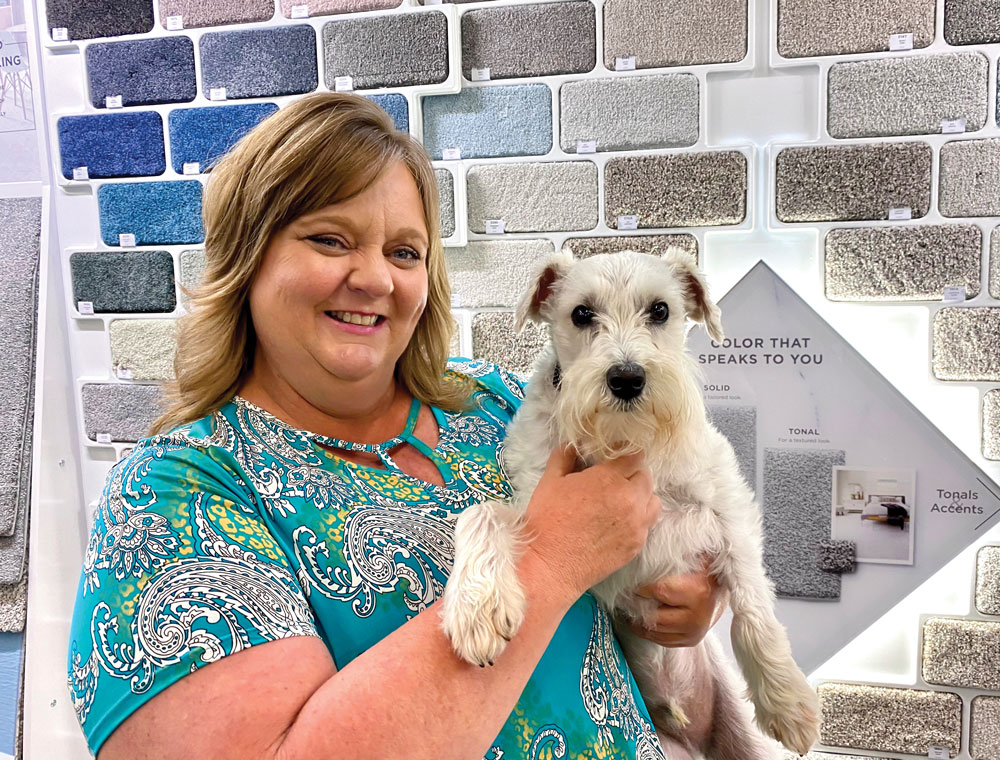
Beau was eight weeks old when Vicki Hubbard first brought him home. Her daughter had encouraged her to get the miniature schnauzer as a remedy for a broken heart, and Beau didn’t disappoint. He was her constant sidekick and even went to work with her.
Last December, Beau, now 5, was hit by a car. Hubbard rushed him to her Baton Rouge veterinarian, who told her to spend time alone with him because he was dying. Yet, each time Hubbard entered the examination room, Beau perked up. The veterinarian noticed and advised her to take the dog to LSU School of Veterinary Medicine Emergency and Critical Care Services to see if his life could be saved.
“I brought him to LSU on a Friday. Three doctors came out right away to take care of him. They said, ‘We’ll do what we can for him,’” Hubbard said.
Virginie Wurlod, Dr.med.vet., DACVECC, assistant professor and head of the LSU School of Veterinary Medicine’s Emergency and Critical Care Service, was on duty when Beau arrived.
“He was unstable, in critical condition. He had traumatic brain injury, a collapsed lung, internal bleeding, and wounds,” Dr. Wurlod said.
Her team went to work monitoring his heart rate, inserting a urinary catheter, supplementing his oxygen, and delivering fluid and antibiotics through an IV. They inserted a chest tube so that a machine could suction air from the chest cavity allowing Beau’s lungs to expand and function.
The team devised a plan that Jamie Hui, DVM, internal medicine resident, presented to Beau’s owner. One option was to remove a lung. The other option: to inject Beau’s own blood into his chest. Hubbard chose the second option, the least invasive.
“The whole afternoon was a blur. I was so afraid I’d get a call after I left saying he’d passed away in the night,” Hubbard said.
When she returned to see Beau Saturday morning he wasn’t standing or walking. She crouched down and talked to him.
“You have to be strong. You have to pull through this, I told him,” Hubbard said.
When she returned Saturday afternoon, Beau stood up in his kennel.
“Everyone was shocked,” she said.
Beau’s clinical team advised her not to return on Sunday because Beau became overly excited when he saw her. The critical care team spends days and nights with injured or diseased animals to ensure they’re doing well and to adjust treatments as necessary.
“When I couldn’t be there, the veterinarian at LSU sent me a video, and it touched my heart. I cried and smiled at the same time watching it. Beau stumbled a few times, but I knew he was going to be okay,” Hubbard said.
Without seeing her constant companion for 24 hours, Hubbard became determined to take Beau home. She returned on Monday with her husband and mother as reinforcement. However, Beau’s doctor said she wanted to keep him for one more day, and Vicki agreed. She brought him home Tuesday.
“He wasn’t 100 percent neurologically normal when discharged after four days, but we knew he would be seen by his regular veterinarian for follow up,” Dr. Wurlod said.
At home, Beau slept a lot for the first few weeks.
“I know his body was still healing,” she said.
Now, Hubbard says Beau is 98 percent back to his normal self. He hops in her car every morning and accompanies her to work at Steve Hubbard Floor Coverings, the Baton Rouge business her family has owned for 35 years. Beau guards the house when Hubbard and her daughter, an LSU senior studying Human Resources, Leadership, and Development, attend LSU football games.
“Beau is an example of how an animal with trauma can arrive in a horrible state, often recover well, and have a great quality of life,” Dr. Wurlod said.
Writer
Sandra Sarr, MFA
Communications Manager
Kirbi the cat gets relief with regular acupuncture treatments
 Published December 1, 2020
Published December 1, 2020
If cats who survive adversity are perceived as having “nine lives,” then Kirbi has lived at least “three lives,” so far, overcoming homelessness, neglect, and physical challenges.
When Kirbi’s owners moved and left her behind to fend for herself, the cat lived under a neighbor’s house. She’d go back to her old house every day waiting to be let inside where she once lived. The neighbor noticed and asked her sister if she would like to adopt the homeless cat. That was nine years ago.
“She was about 2 years old when we brought her home. We had no idea what her name was, and so we named her Kirbi,” said Joycelyn Bueche, who lives in Plaquemine, La., and manages the Iberville Parish Schools Performing Arts Center.
Jocelyn had two dogs, and she wasn’t sure she wanted a cat, especially a long-haired cat that would shed. The cat was in heat when Joycelyn got her. Joycelyn took her to a veterinarian for an examination, treatment, and preventatives, and had her spayed.
Kirby, now 11, enjoys sunning herself on the family deck.
“She’s been the best cat. She never ventures anywhere,” Joycelyn said of Kirbi, who is apparently content at home and not curious about racking up all nine of cats’ fabled lives.
One day, in early 2018, Joycelyn’s oldest grandson and his girlfriend noticed that Kirbi was limping. After visits to her regular veterinarian, she showed no improvement. That’s when the veterinarian suggested Joycelyn take Kirbi to LSU, where a CT scan showed elbow dysplasia, a condition involving abnormalities of the elbow joint.
“We thought it was arthritis. When we learned what it was, we decided to try acupuncture treatments, and we were lucky enough to get Dr. Lorrie Hale,” Joycelyn said.
Lorrie Hale, DVM, CTCVMP, began seeing Kirbi in February 2018 and continues to treat her. Dr. Hale is certified in veterinary acupuncture, Tui-na (massage to realign the body), Chinese herbal medicine, and food therapy. She has earned the title of Certified Traditional Chinese Veterinary Medicine Practitioner, one of only three certified in Louisiana and one of only 59 in the world.
“Cat acupuncture is amazing. And Kirbi likes it. It’s really helping her,” Dr. Hale said.
Joycelyn brings her every six weeks for acupuncture to relieve symptoms of elbow dysplasia.
“Lorrie is wonderful, and her personality is a delight. She truly cares about Kirbi’s wellbeing. She’s always open and honest about everything. She knows Kirbi, and the cat knows her and responds well to her. The acupuncture definitely helps,” Joycelyn said, who added that she’ll continue the treatments until there’s cause to make another decision.
Acupuncture, an ancient healing technique first documented in China, involves inserting small needles into key areas of the body, helping to re-establish physiological balance. When treating a cat, it is helpful that there is usually more than one point that can be chosen to insert a needle and address a condition, allowing the veterinarian options when working with a pet.
“I was surprised at how accepting Kirbi was of needles. It’s amazing. They don’t seem to bother her.
Her quality of life is good. She still occasionally limps, but her life is not diminished,” said Joycelyn.
Joycelyn said Kirby’s acupuncture treatments are a priority in her life.
“I tell people at my work, ‘I’ll be in at noon today, Kirby’s going to LSU for her acupuncture,” said Joycelyn, who doesn’t mind the 60-minute round trip to appointments.
She said that if her dogs need it, she will bring them for acupuncture treatments, too.
The LSU Veterinary Teaching Hospital’s Integrative Medicine Service includes acupuncture, Tui-na, Chinese herbal medicine, food therapy, and rehabilitation service for small animals, horses, exotics, and farm animal species. Expert services are provided by trained and certified individuals encouraging patient healing and improved well-being by augmenting traditional medical and surgical treatments with traditional Chinese veterinary medicine and rehabilitative services. The integrative medicine service works collaboratively with other veterinarians within the LSU Veterinary Teaching Hospital to provide the best care possible.
The LSU SVM’s Integrative Medicine Support Fund was established by Sue and Donald Crow, helping to create one of the foremost integrative medicine programs in the nation.
Contact
Sandra Sarr, MFA
Communications Manager
Blue, miniature Dachshund, healed after receiving emergency services and then acupuncture after attack by neighbor’s dog
Published December 2, 2020
The attack happened on Mother’s Day 2020. Britton Ritter had just returned from the grocery store, and her daughter, Arden, and miniature Dachshund, Blue, greeted her in the driveway, as they liked to do.
“When they came out, I heard Blue yelp and my neighbor scream, ‘Apollo!’ at her dog,” Britton said.
Blue had put himself in between Britton’s daughter and the other dog to protect her. Four-year-old Arden jumped inside the SUV to safety. It took Britton a few seconds to fully realize what was happening.
“I saw his back legs dragging and said, ‘Oh my God, he’s paralyzed,’” Britton said.
She packed up Blue, age 10, and rushed him to the LSU School of Veterinary Medicine, where he was found unable to move or bear weight on his right hind limb.
“Blue either had a fibrocartilaginous embolism, basically the spinal cord equivalent of a stroke, or had a trauma-induced intervertebral disk disease. His condition worsened over the next 24 hours,” said Ryan Smith, DVM (LSU SVM 2009), DACVECC, assistant professor of emergency and critical care.
By morning, both hind limbs weren’t functioning, and he wasn’t urinating. Blue stayed in the ICU overnight.
“They told us they could do an MRI to know for sure what was going on, but that it wouldn’t change the course of treatment. Dr. Jessica Sullivan in the Surgery service was phenomenal. We avoided surgery. She suggested acupuncture,” Britton said.
Fortunately, Blue’s condition did not deteriorate further and was managed with pain medications, anti-inflammatories, and cage rest. It was suggested that Blue see the LSU SVM’s Integrative Medicine service for physical therapy and additional treatments.
“I had instant trust because of the way they communicated the treatment plan. They were open and honest. They were so comforting when I was so scared. I thought I’d have to put him to sleep,” she said of the dog she’d known since he was born.
The first visit involved evaluation, and 10 acupuncture sessions were recommended to help Blue.
“The veterinarian spent 25 minutes giving me a range of options so I could decide. She told us we could take it week by week, evaluate how he was doing, and come back as needed. She was conservative with my money,” Britton said.
Blue needed a harness to stand and to go outside to urinate. He struggled with bowel control.
“He’s very sensitive and would be ashamed when going in the house,” she said.
At the LSU SVM, he started with physical therapy two times a week and acupuncture once a week.
“I saw instant improvement with the therapy. I thought he’d never walk again. It was a huge improvement,” said Britton, who was given exercises for Blue to do at home.
Britton says one of Blue’s legs functions at 100 percent and the other at 70 percent.
“I thought it would take six months of treatment to get there, but it took less than three months,” said Britton of her prized dachshund.
“We’re the crazy wiener dog family. My mom and dad had a male and female dachshund, and we got one of the puppies, Blue. I’ve had him longer than my daughter,” she said.
When the Ritters first brought baby Arden home, Blue did fine around her and became protective of her,” Britton said. Both she and her husband are LSU alumni: she in marketing, and he in construction management with a master's in Finance, which they put to work for their construction company.
“It was a blessing Blue’s injury happened on a Sunday, and we ended up at the vet school. Treatment has restored her mobility to nearly 100 percent,” Britton said.
Contact
Sandra Sarr, MFA
Communications Manager